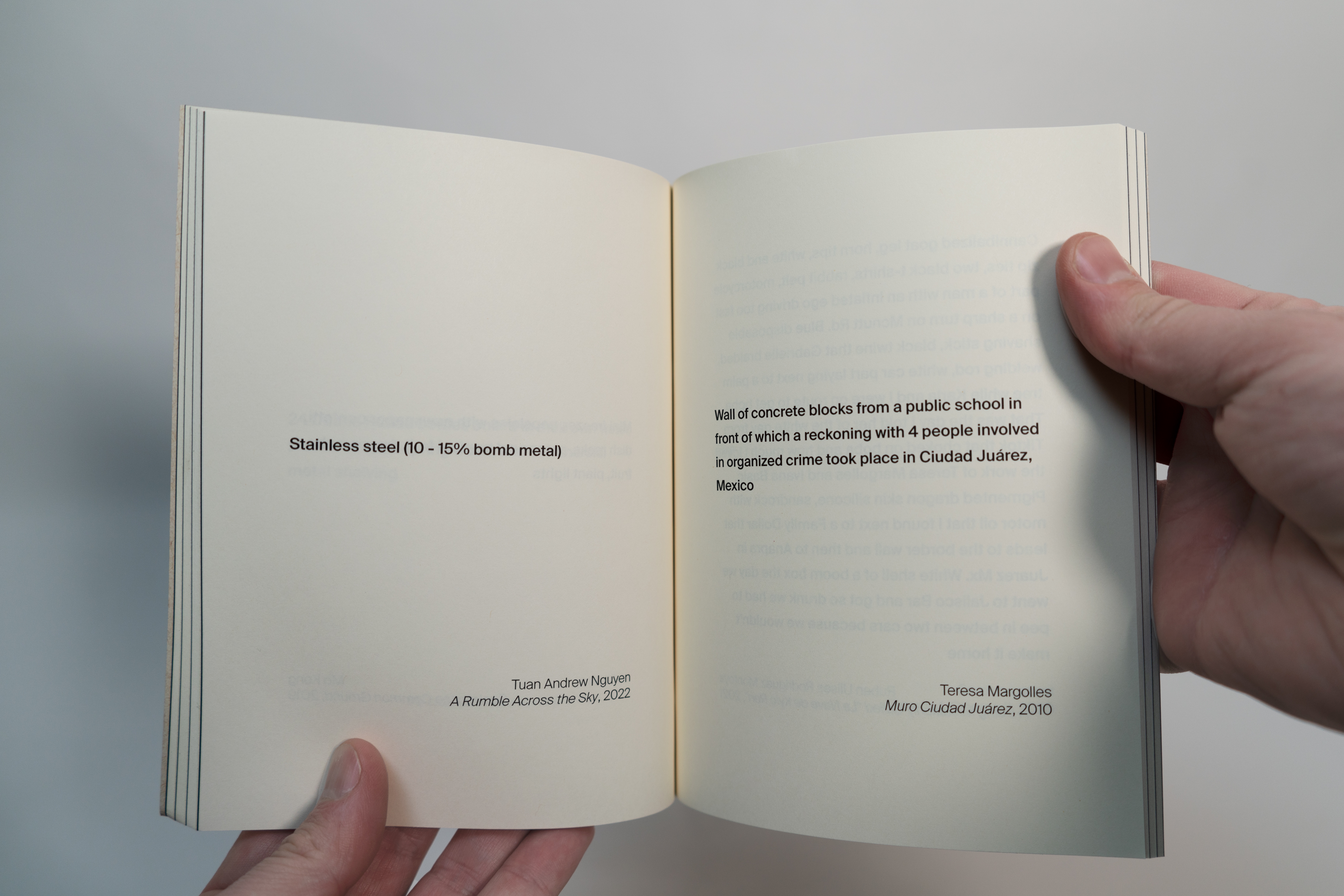contact: max.aaron.spitzer@gmail.com
info: click here
an arrow of all fletch
2024
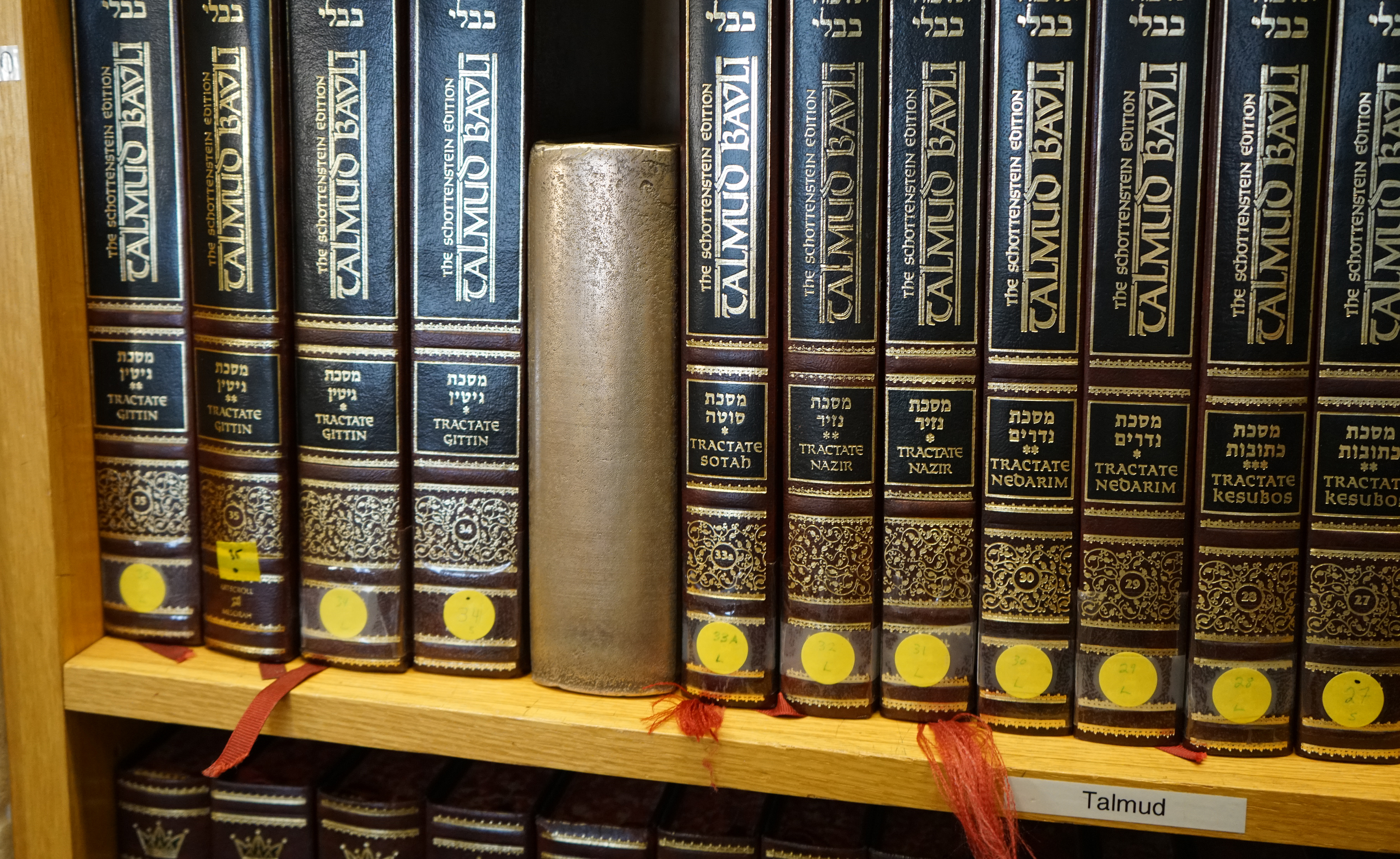
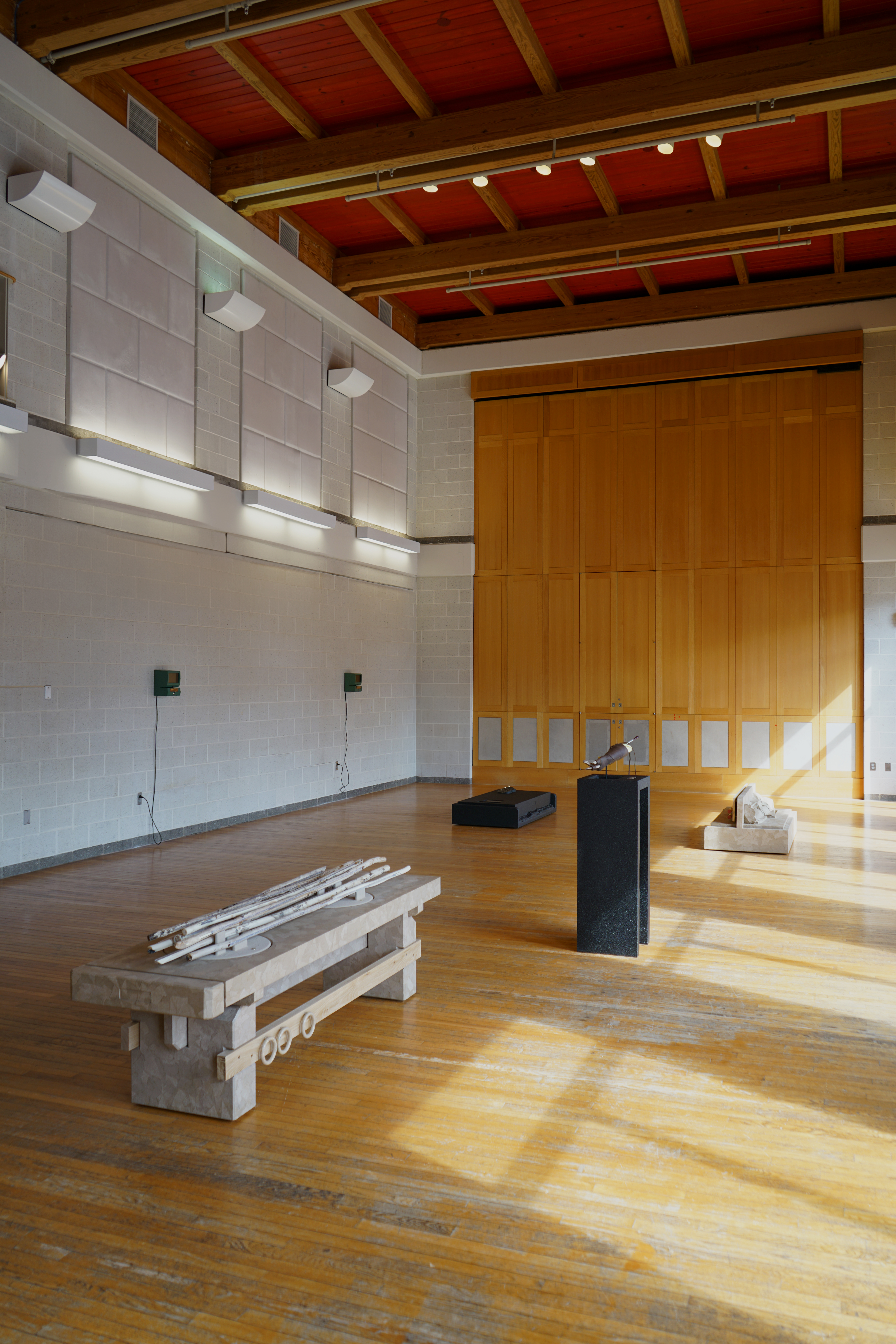
“The left-wing feathers were for R-handed scribes, as those feathers curved away from the sight line and over the hand. Scribes opted to change nib angles - cut with a penknife - rather than the angles at which they held their pens, and so contorting their hands and depleting them…The quill’s notched point, like an arrow’s, the quill itself an arrow of all fletch.”
-Joshua Cohen, Attention
“What have I in common with Jews? I have hardly anything in common with myself.”
-Kafka

Now, you find yourself evaluating every moment for its efficacy. You’re anxious and distracted. But you have a routine of acknowledging authority. Touching it at the threshold: Re-membering powers that be. Card slipped inside. You follow its instructions. You’re punching in. You’re on the clock. It is time to attend.
I had some thoughts about moods of attention and distraction: The way my body attended differently to linguistic and material expressions. How this all is tied to difficulties with communication, and how these concerns might be made apt for a Jewish audience. My selection as Blanksteen Artist-in-Residence was announced on October 6th, 2023. On that day, I was excited to spend the upcoming months exploring these aesthetic concerns. Soon these would be concealed by other anxieties.
A focus on attention was subsumed by an interest in legibility. Here, words bear meaning like arms to varying degrees. All the text in this show is lifted and re-presented: Some clear (though many meanings are still blurry to me), and some are entirely opaque: sealed within the work. There is a book made of bronze. It contains contributions from the Blanksteen cohort, and the contents of all the contributions -are far as I know- have not yet been revealed. Welded shut, it will stay on the shelves in the reading room upstairs. I am glad that the Slifka Center has agreed to hold space for the unknown.
This work was made possible with help from Anny Chen, JC Christy, Norwood Viviano, Paul Whittenbraker, Caroline Bell, Destin Nordyke, Aimi Hettinger, Cecilia Lopez Nieves, Irlanda Beltran, Claire West, Flora Ranis, Caleb Tacoma, and many others.



Cheltenham Sticks
Birch, oak, acacia, brass, paper mache, pencil shavings, straw, flour, rabbit feed, bird feed, meal replacement powder, aspartame, sand, sticks, text, envelope, golf ball, epoxy resin, epoxy clay, wax
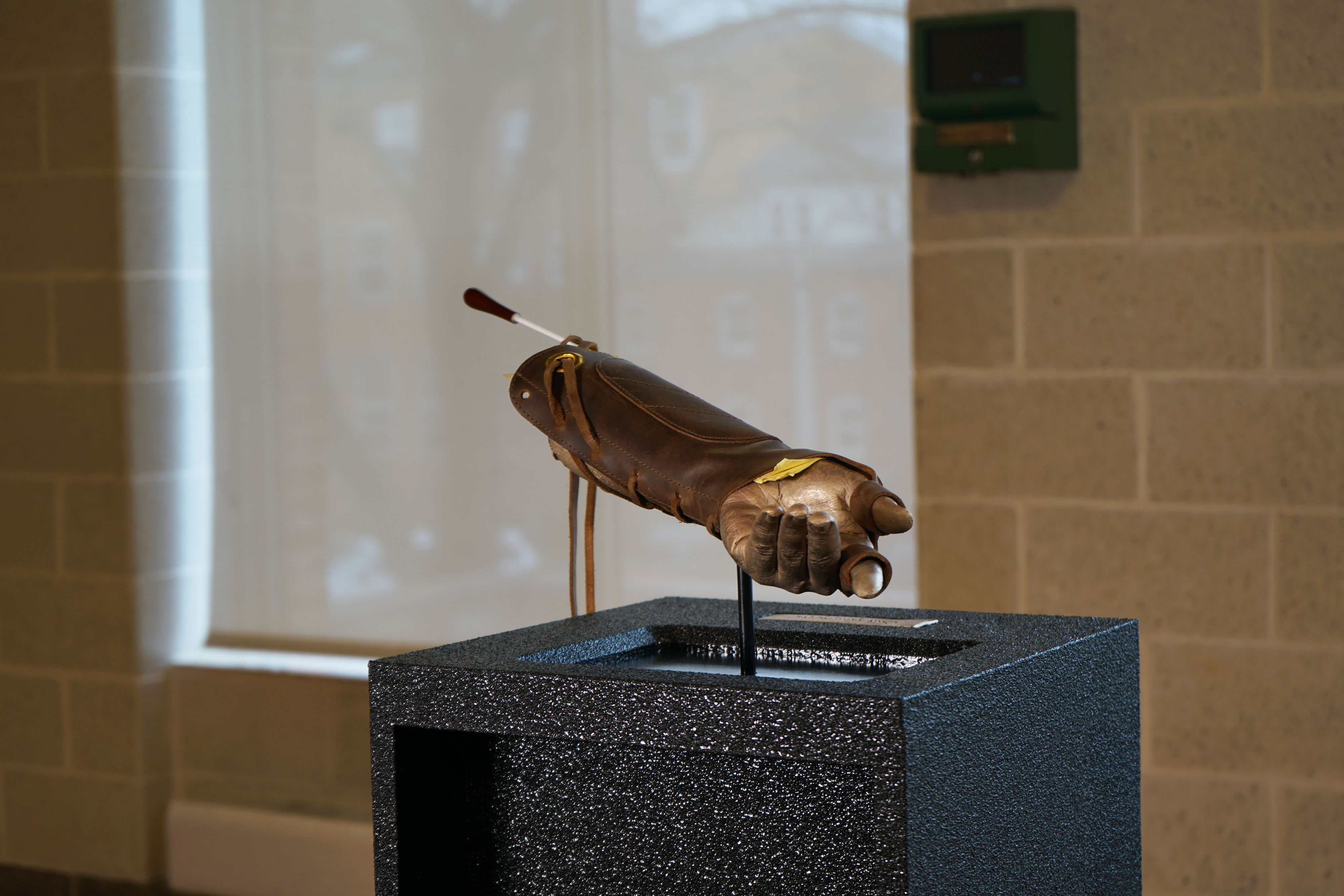
Untitled Homage to Warrior Reliquary (Quit your tents.)
Bronze, bracer, to do list, baton, truck bed liner, plywood, polystyrene, painted steel, sand

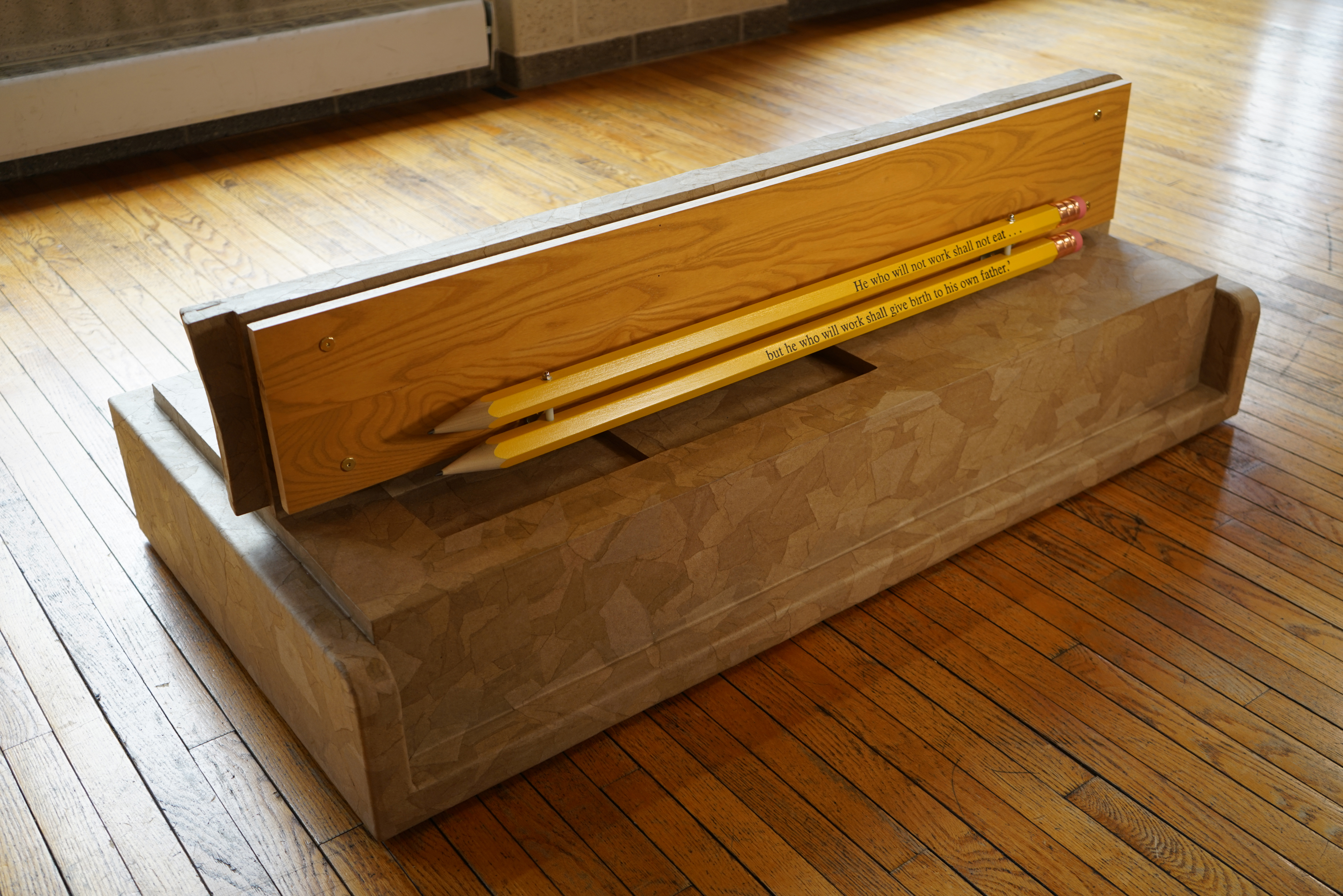
Double Effigy
Paper mache, plaster, wood, steel, two novelty size pencils with George Oppen’s Of Being Numerous
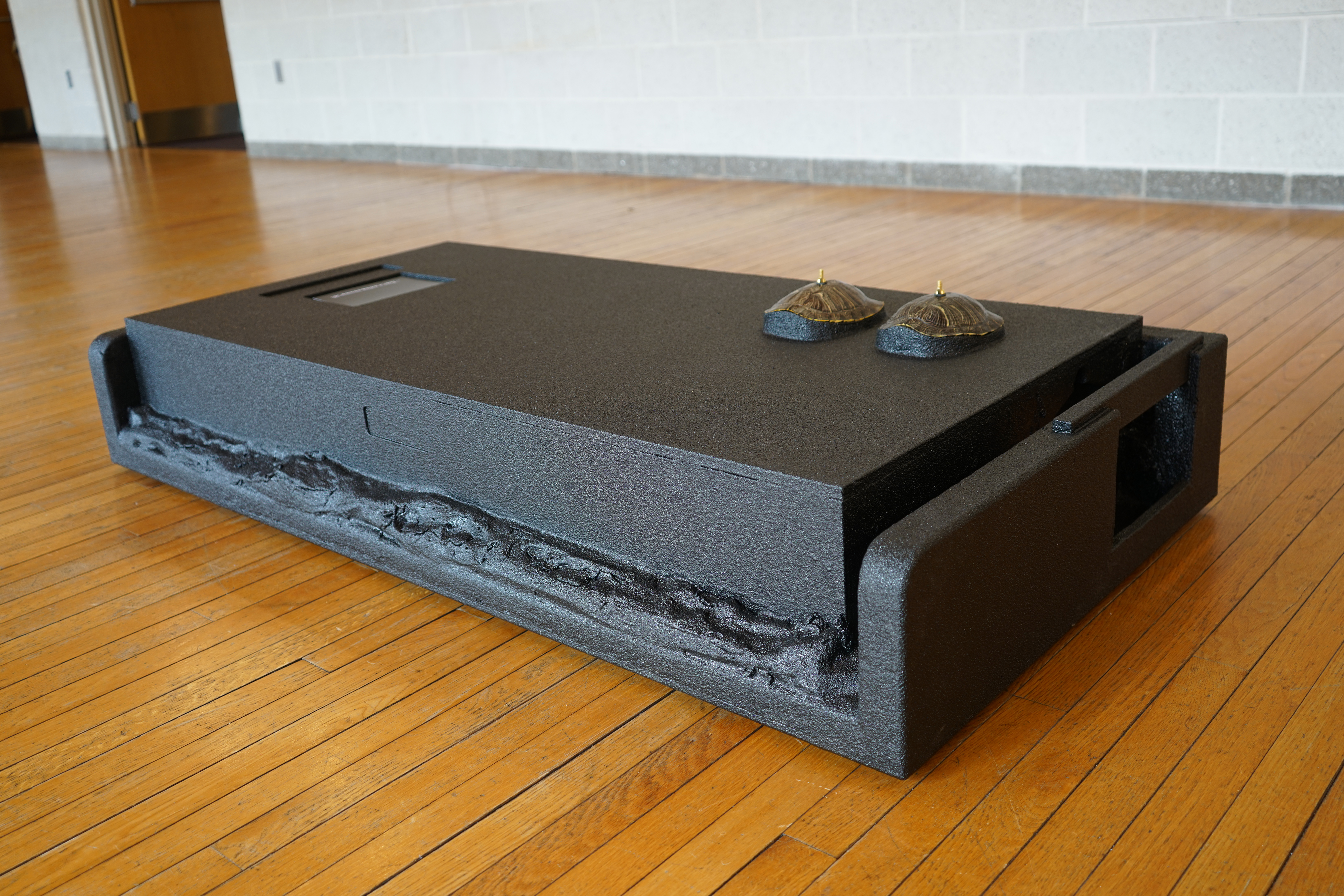

Double Shell Consecration
Plywood, plaster, oak, truck bed liner. two box turtle shells with perforated Nalgenes containing consecrations & printed material, wing nuts, pre-stamped postcards addressed to Rosa DeLauro with Theodor Adorno’s Minima Moralia


PC:S (Lead Melakhot)
PC:M (The Featherduster)
PC:T (Arrow of all Fletch)
PC:W (Deficit Creed)
PC:Th (Aspartame Achilles)
PC:F (A Feather Thrown into a Canyon)
Six modified Acroprint 150s, olive wood, bronze, videos with Normon Solomon’s The Talmud: A Selection, onyx, acrylic, Italo Calvino’s If on a Winter’s Night a Traveler..., Louise Glück’s The Triumph of Achilles, aspartame, Abraham Joshua Heschel’s The Sabbath, hand of Serra, hand of Brooks, hand of Karajan, various other appropriated texts and footage
excerpts:
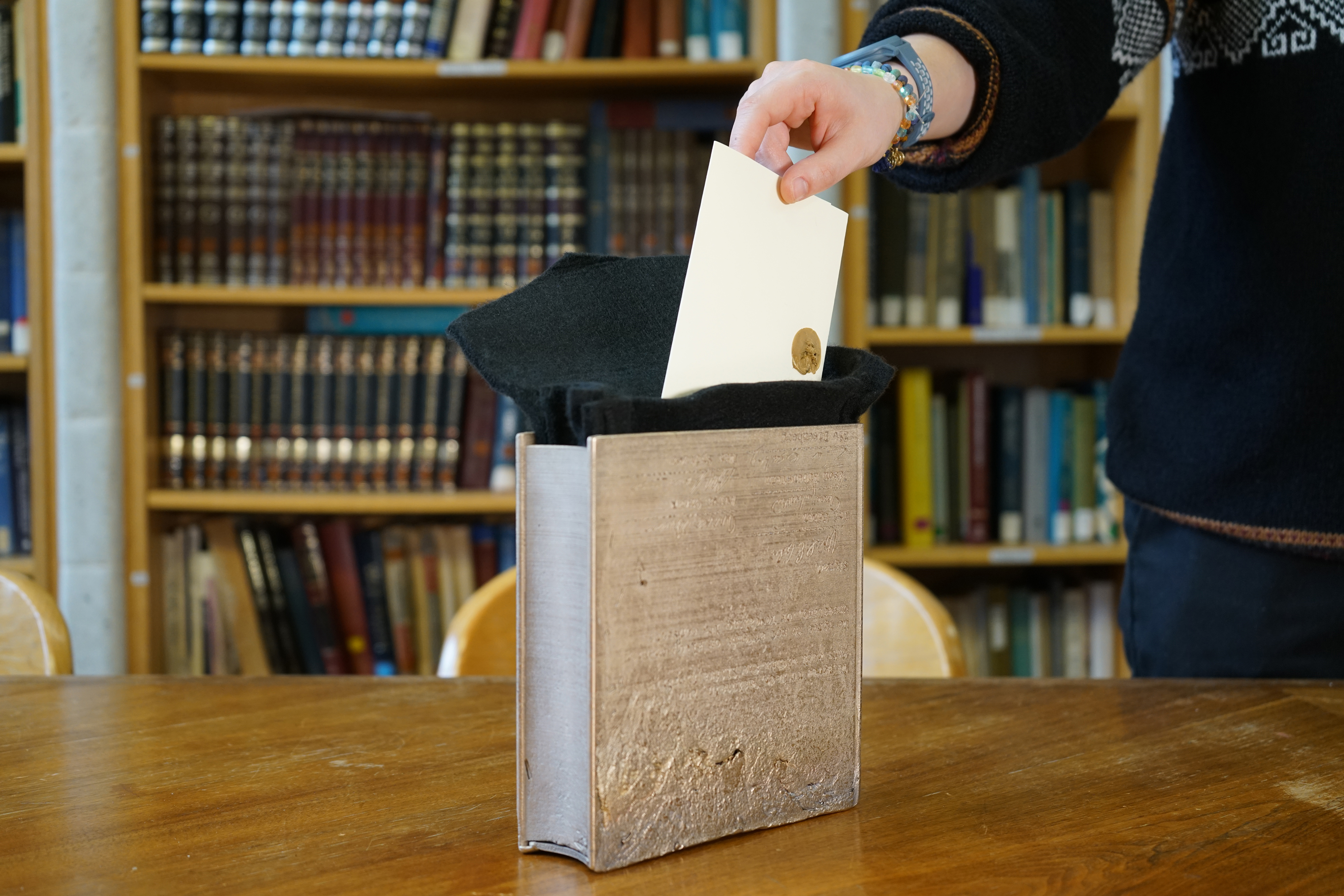
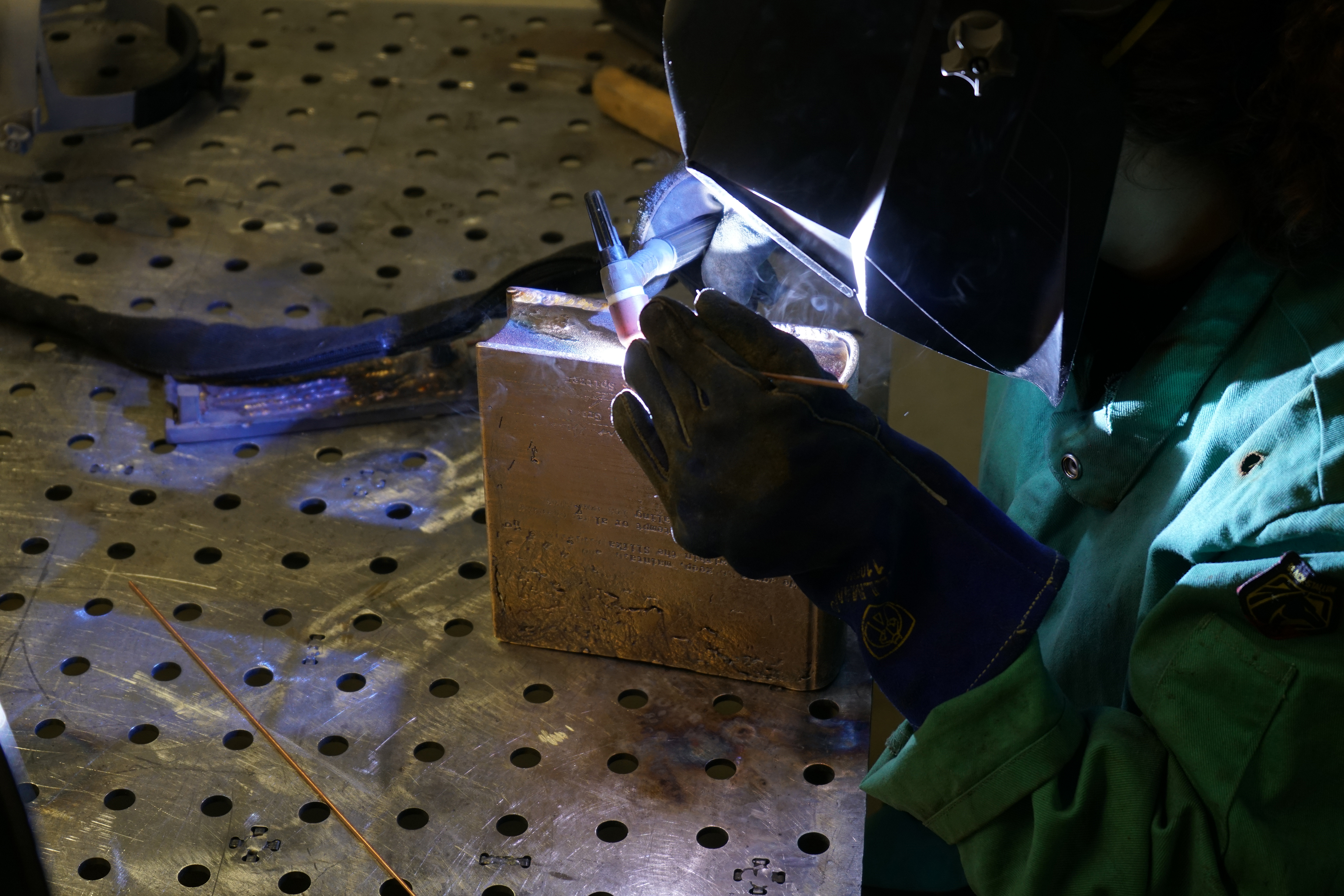
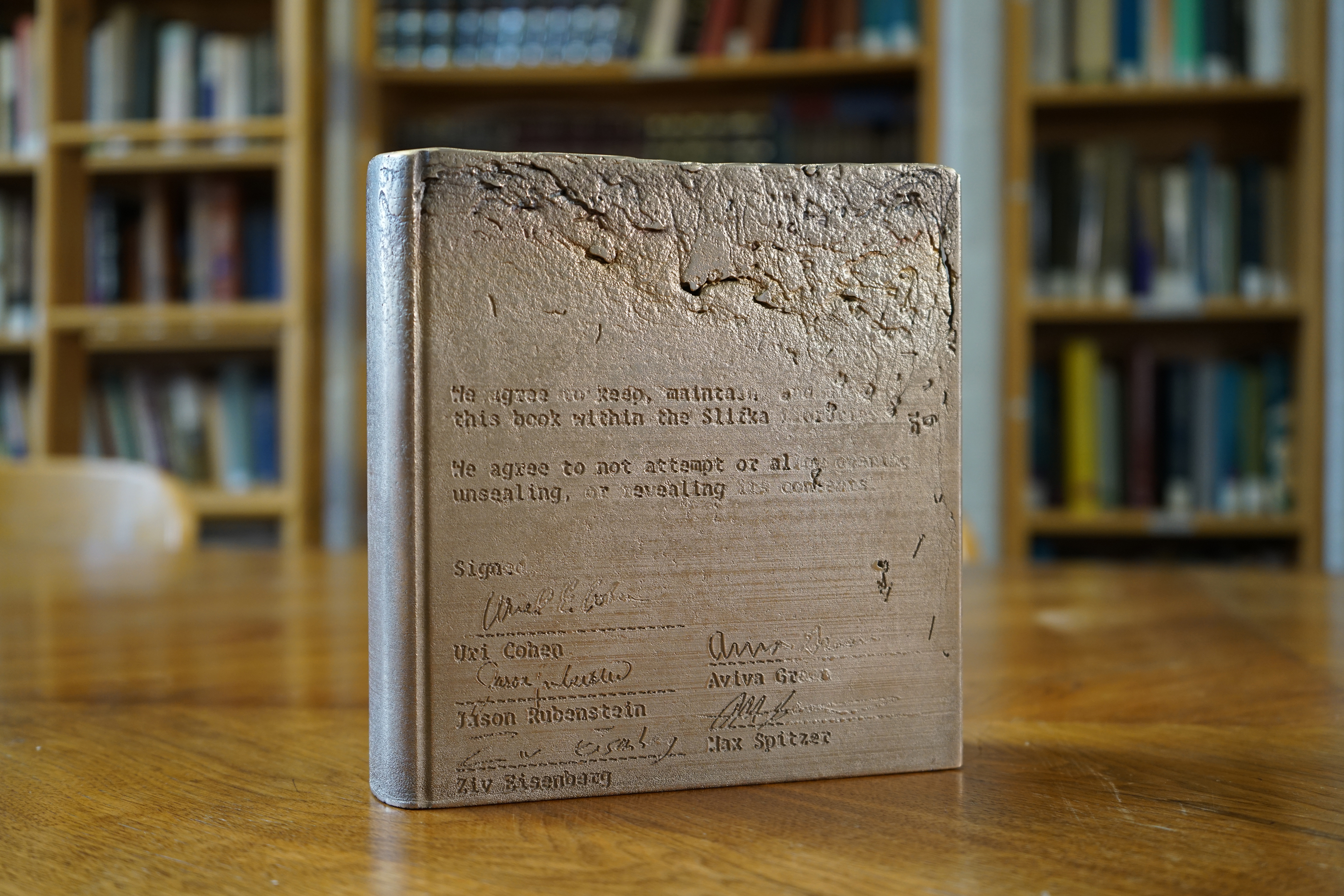
Untitled Tome
Cast and welded bronze, carbon felt, undisclosed contributions.
Permanent installation.
Click here to read about this project in an essay written by Rujuta Rao and published in Vol. III of Peer Review.
2021

My dad wrote to tell me that my great-great-grandparents’ grave markers were going to be replicated and replaced. The markers had eroded to near illegibility after witnessing almost a century of seasons in Niagara Falls, NY. Each winter droplets of mist froze in the porous sandstone, expanding and taking bits of text away as it thawed.
He wrote that it would be a shame to discard or destroy the stones, and so asked me if I wanted them for some artistic purpose. Another reason why I may want them, he reminded me, is that one has my own name carved into it. The great-great-grandfather buried there, Max Spitzer, is the one I inherited my name from.
Max’s oldest son’s name was Martin, and his oldest son’s name was Matthew, and his oldest son’s name was Mark, and his oldest son is me.
Having agreed to take responsibility for the tombstones, I soon travelled up to visit the cemetery where they sat, a few miles downstream from Niagara Falls, wedged between a highway, some chain link fence, overgrown grass, and the Robert Moses Niagara Hydroelectric Power Station. It’s infrastructure diverts water away from the Niagara River so that, rather than being drawn down over the edge of the falls, it finds a resting place in Lewiston Reservoir -before it takes another form and flows through the high voltage lines, which buzz and swoop above the cemetery.
And so, this project became one of possessions, and of materials possessed. Can I exhume the moments where patrimony is haunted by patriarchy? How many replications, transubstantiations, reanimations, can these things endure, and still sustain some mute, inner essence? Each substance is a reliquary for some spectral meaning, subsisting on suppositions that the provenance conveyed is true.
Photons travel from the sun, absorbed and reflected into our eyes, illuminating an image of eroding words: ‘lead kindly light.’
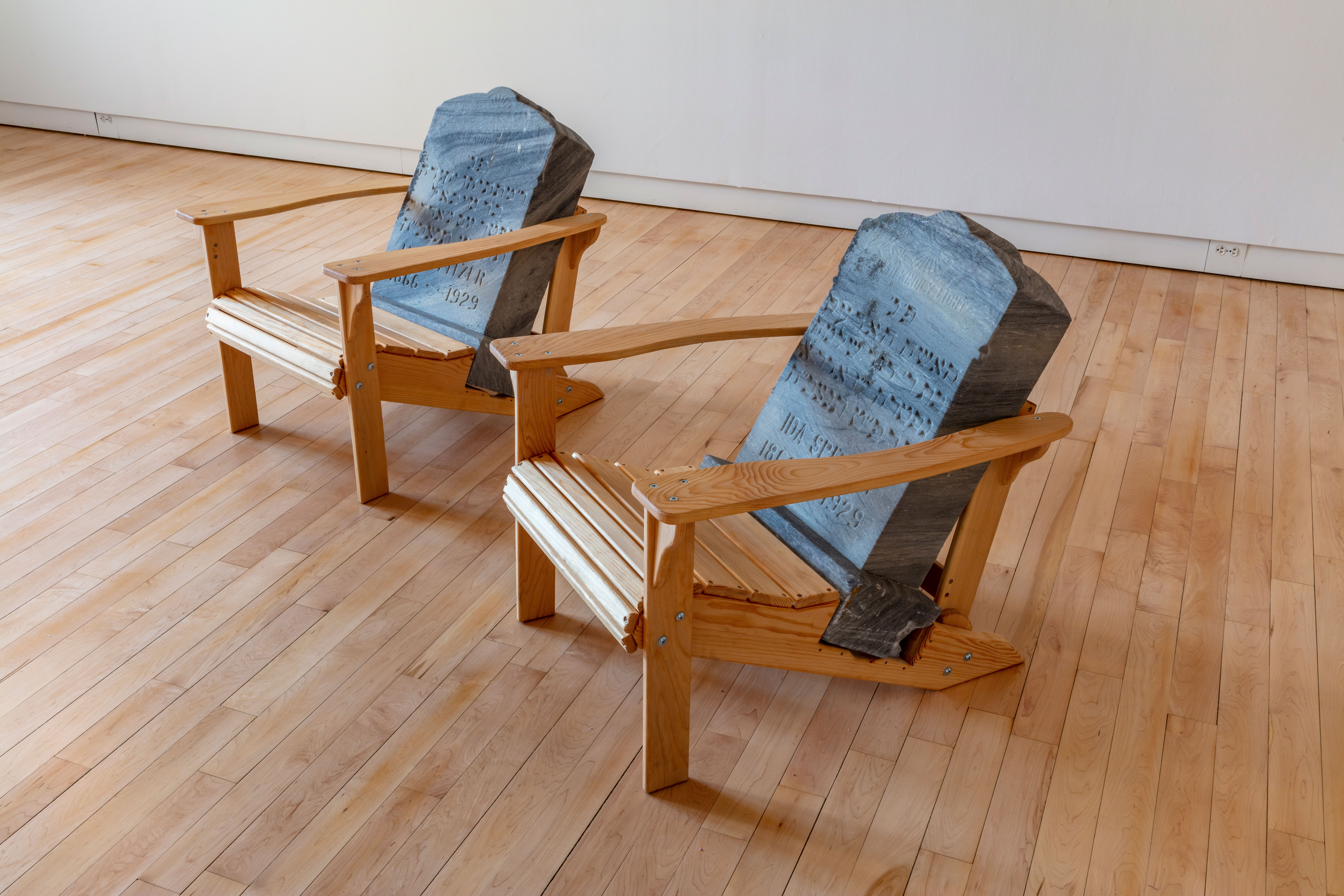

Our Erosion, 2020
hemlock and sandstone
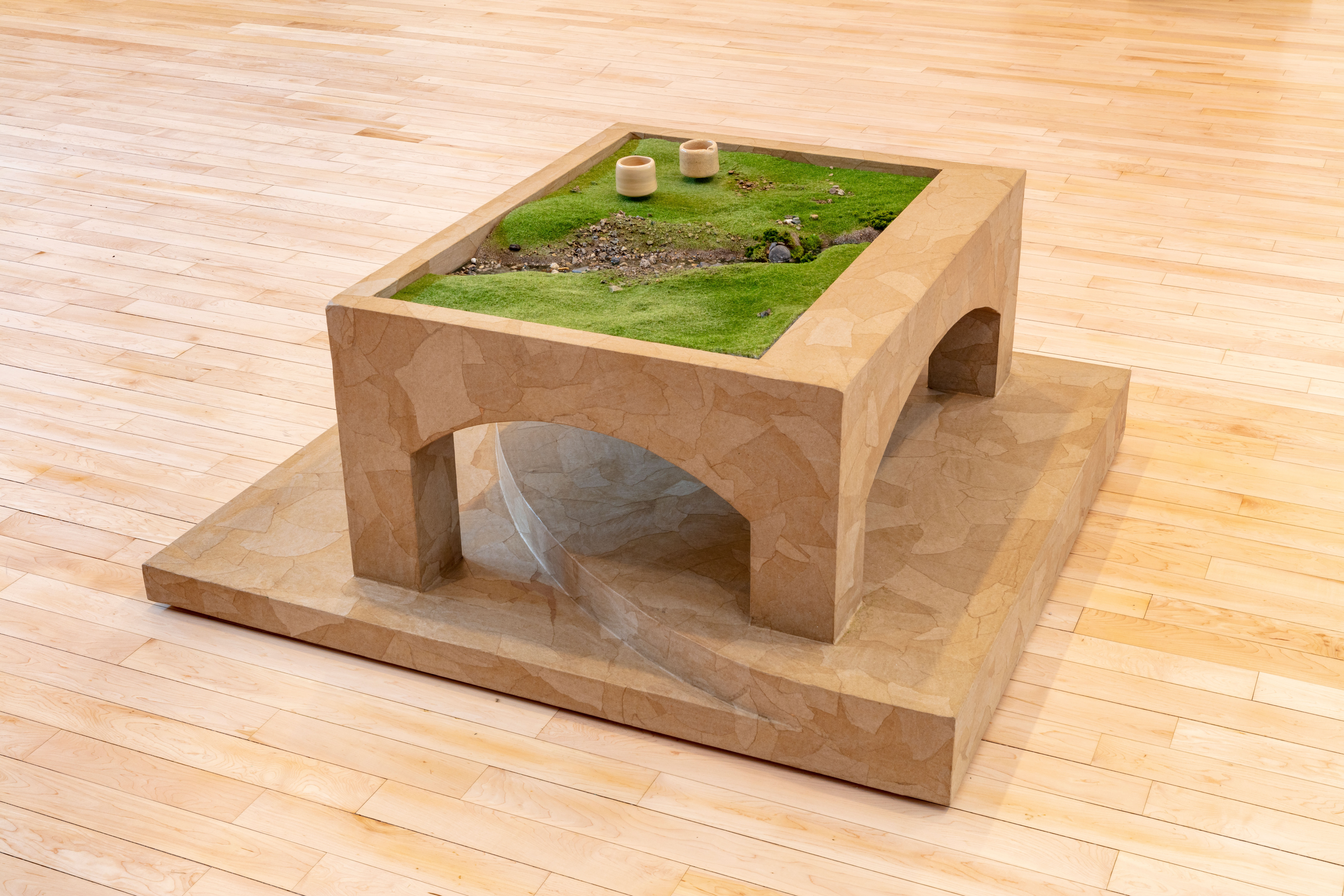
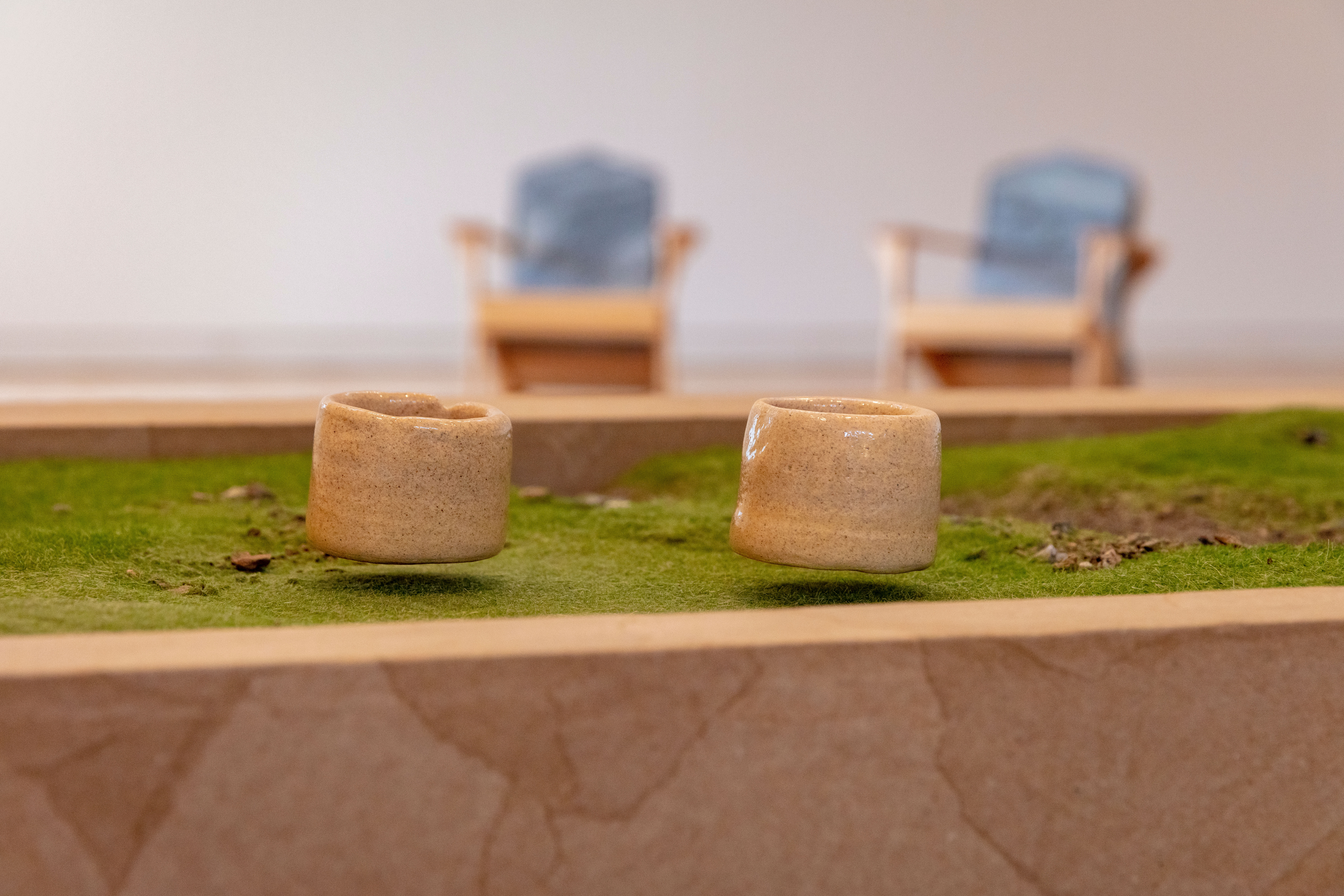
Haunt, 2021
paper mache plinth, model landscape, ceramic cups incorporating tombstone dust

Still Niagara, 2021
paper mache plinth, video

2023

Reading Materials, produced in collaboration with Talya Petrillo and featuring a introcution by Harry Dodge, is a collection of artists’ material lists published without accompanying information or images. The project archives the diversity of strategies which contemporary artists and institutions have employed as they confront the obligation to articulate materiality. The selections highlight the linguistic perculiarities and poetic potential of the didactic material list form, and catalyzes conversation about authorship and the boundaries of a material work in contemporary exhibition.
![]()
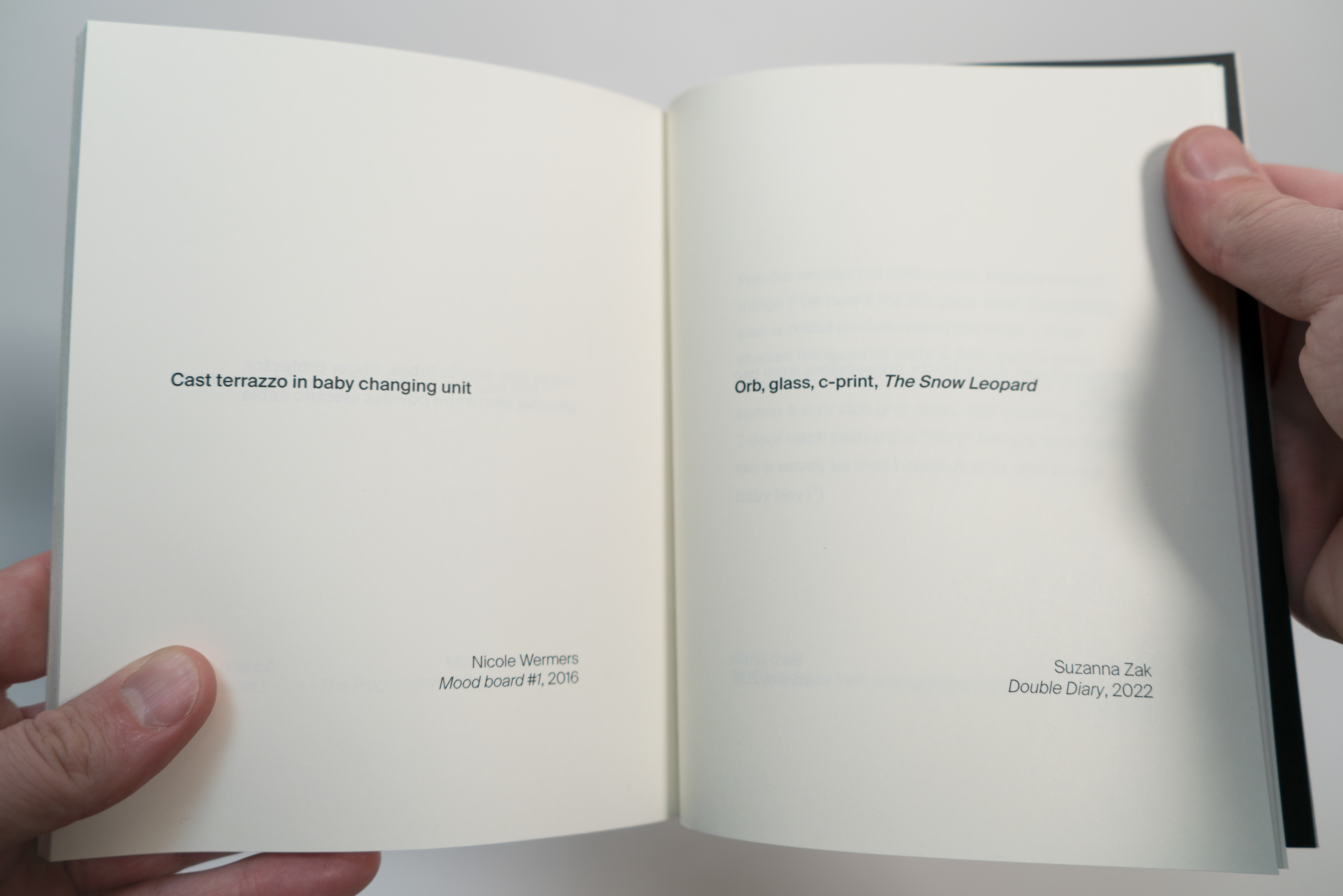
2022
Installed at the Children’s Museum of Pittsburgh, this project invites visitors to play with the physics of a 12 circular air hockey table. Air passes through its circular composite body and through its perforated steel, allowing objects -provided by the museum and constructed by kids- so glide and ricochet around its surface.


Dandelion*
March, 2019

*Some Dandelion facts: The word Dandelion, is a corruption of the French ‘dent de lion,’ which means ‘lion’s tooth,’ a name referring not to the flower but to the jagged toothy leaves. But, the flowers’ ubiquity has earned it many other names including: cankerwort, witch’s gowan, monk’s head, priest’s crown, milky, butter flower, blowball, faceclock, and puff-ball (these last three referring specifically to the phase when the dandelion has aged from a yellow flower to a sphere of silver wisps ready to disperse seeds on the wind.) It has also been called the piss-a-bed, referring to it’s diuretic qualities. It has also been called dog-pisses, for the way that it likes to grow at the edge of the pavement. The dandelion is closely related to the endive. It is a member of the daisy family. The dandelion is considered a weed by adults who own lawn mowers. According to The Invasive Plant Atlas of the United States it was brought to North America by European Colonists in the seventeenth century who enjoyed using its leaves as salad greens.

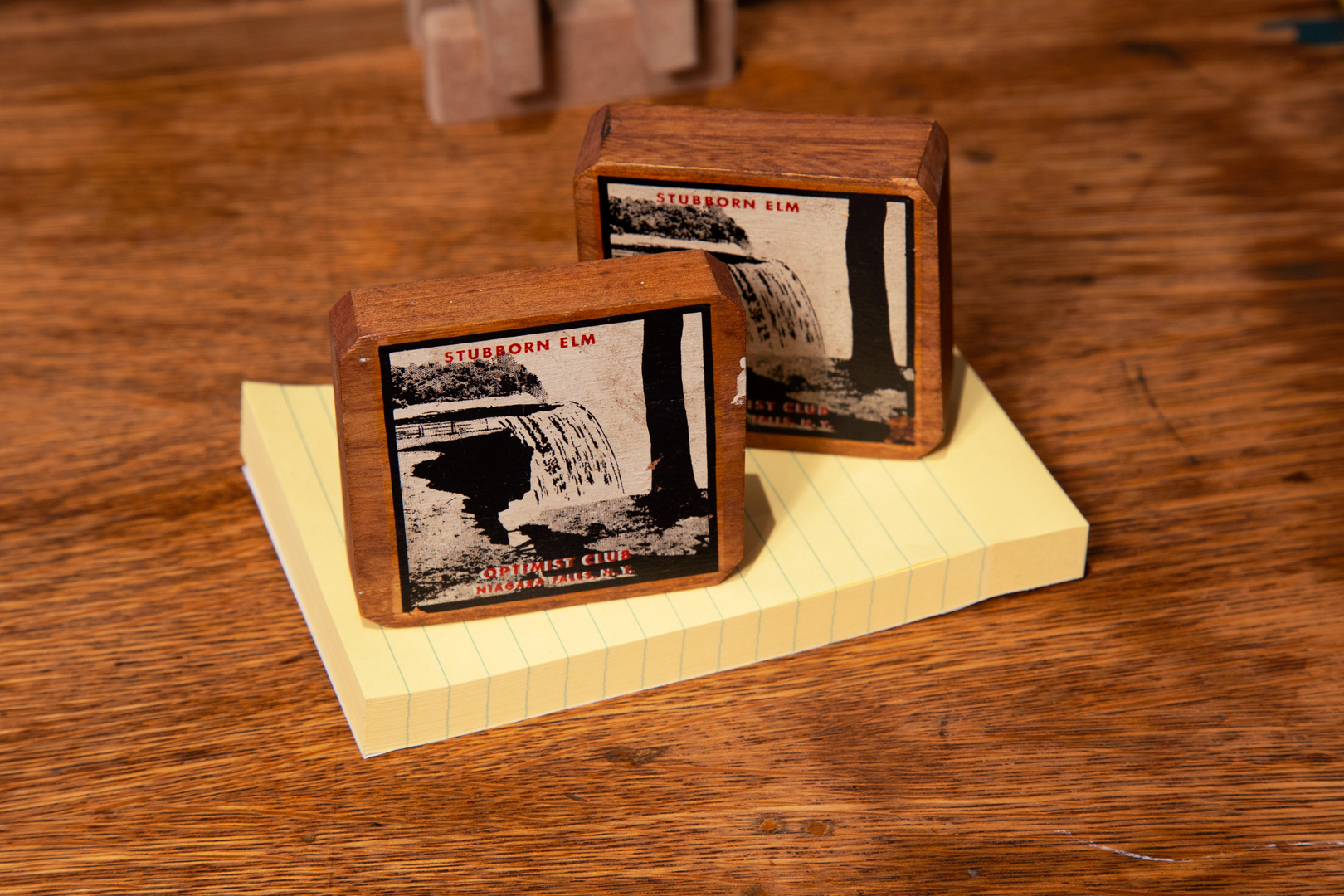
Optimist Club Table
2018
2018
Desktop handed down from my father (with repairs in the veneer by my father -done correctly- and by me -done with emerald green pigmented resin-) with bark brown pigmented resin inlay (in my father’s handwriting and also inspired by this one Robert Gober potato print of Rodgers and Hammerstein sheet music,)1 -just like what even is a potato print?), pad of yellow lined adhesive note pages, two blocks of elm with print which reads “Stubborn Elm / Optimist Club / Niagara Falls, NY” on the front and “This is an authentic piece of the stubborn elm which withstood the 185,000 ton rockfall of July 23, 1954 at Niagara Falls, N. Y., and hung precariously but tenaciously despite all effort of men and dynamite to dislodge it. Many thousands of people from all over North America came to view this tree which became nationally famous overnight. On August 24, 1954 at 3:26 p.m., eastern daylight time, a terrific rainstorm and bolt of lightning finally crashed this magnificent tree to the gorge below, and accomplished what man had failed to do. / We like to believe that this tree is symbolic of the strength and determination of the people of our great continent, and that only god controls our destiny.” on the back, and which I can tell you much more about if you ask
1. and why don’t we refer to dandelions as invasive? Did we ever? If anything is, they are. From Eurasia originally. A few centuries ago. But has travelled everywhere becasue colonists like to garnish their salads.


The Fellowship
2019
2019
Paper mache over particle board and styrofoam, plywood, fiberglass reinforced mini box shims, laser cut acrylic, lighting, paint, and images of: Max Beckmann, Max Bialystock, Max Bunny, Max Cady (1962), Max Cady (1991), Max Detweiler, Max Ernst, Max Zorin, Max Fischer, Max Headroom, Mad Max, Max Martin, Max Richter, Max Rebo, Maximilian Veers, Max Roach, Max Rothman, Max Weber, Max, Max, Maxim Gorky, Maximilien Robespierre, Maximus Decimus Meridius, Maxwell Smart, Maxwell, and Miracle Max
2. Though Miracle Max from The Princess Bride, Max from Thomas the Tank Engine & Friends, and Max from Where the Wild Things Are do not have last names, and the Neo-Soul/R&B artist Maxwell’s stage name is derived from his middle name, the titular Mad Max’s last name is actually Rockatansky.

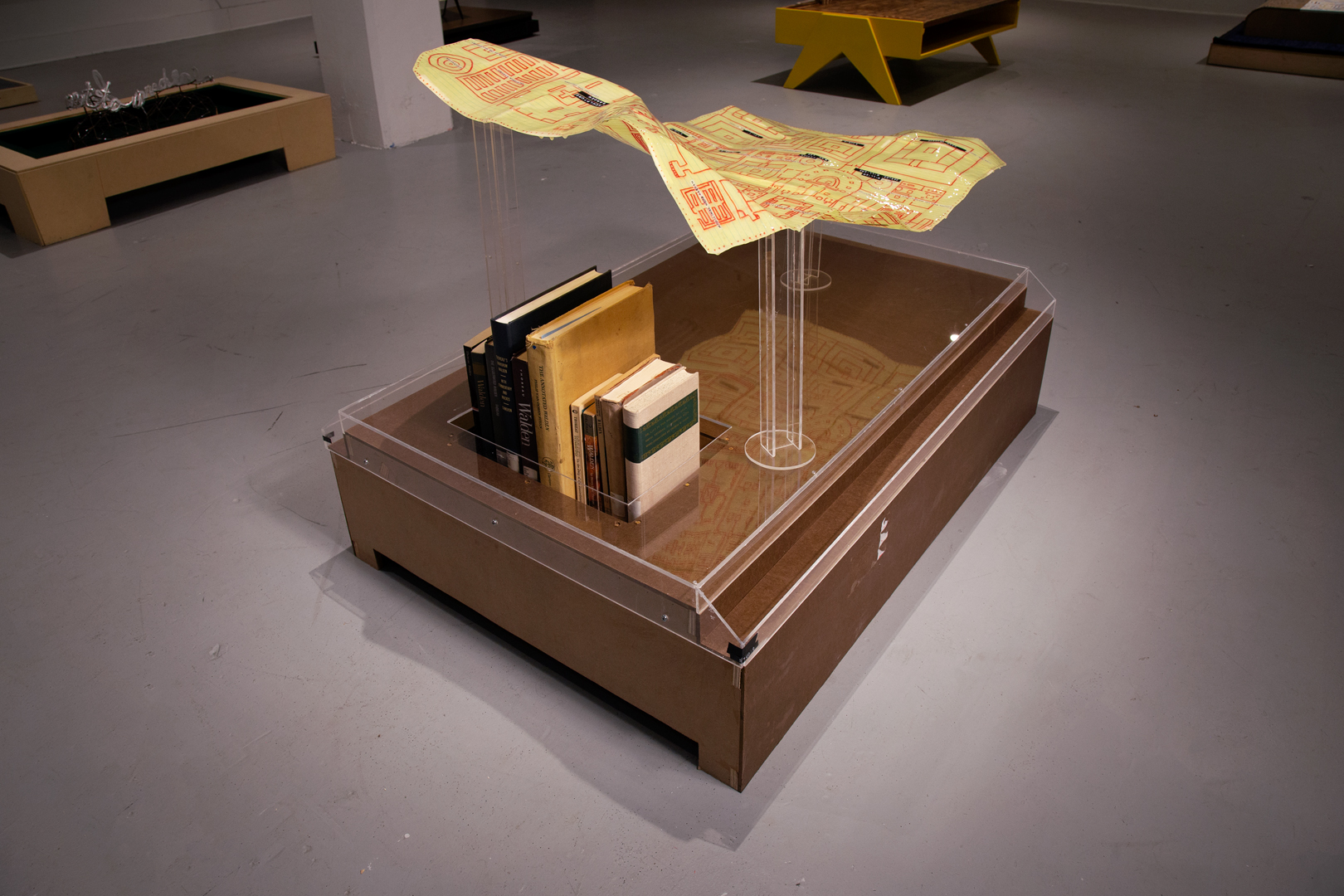
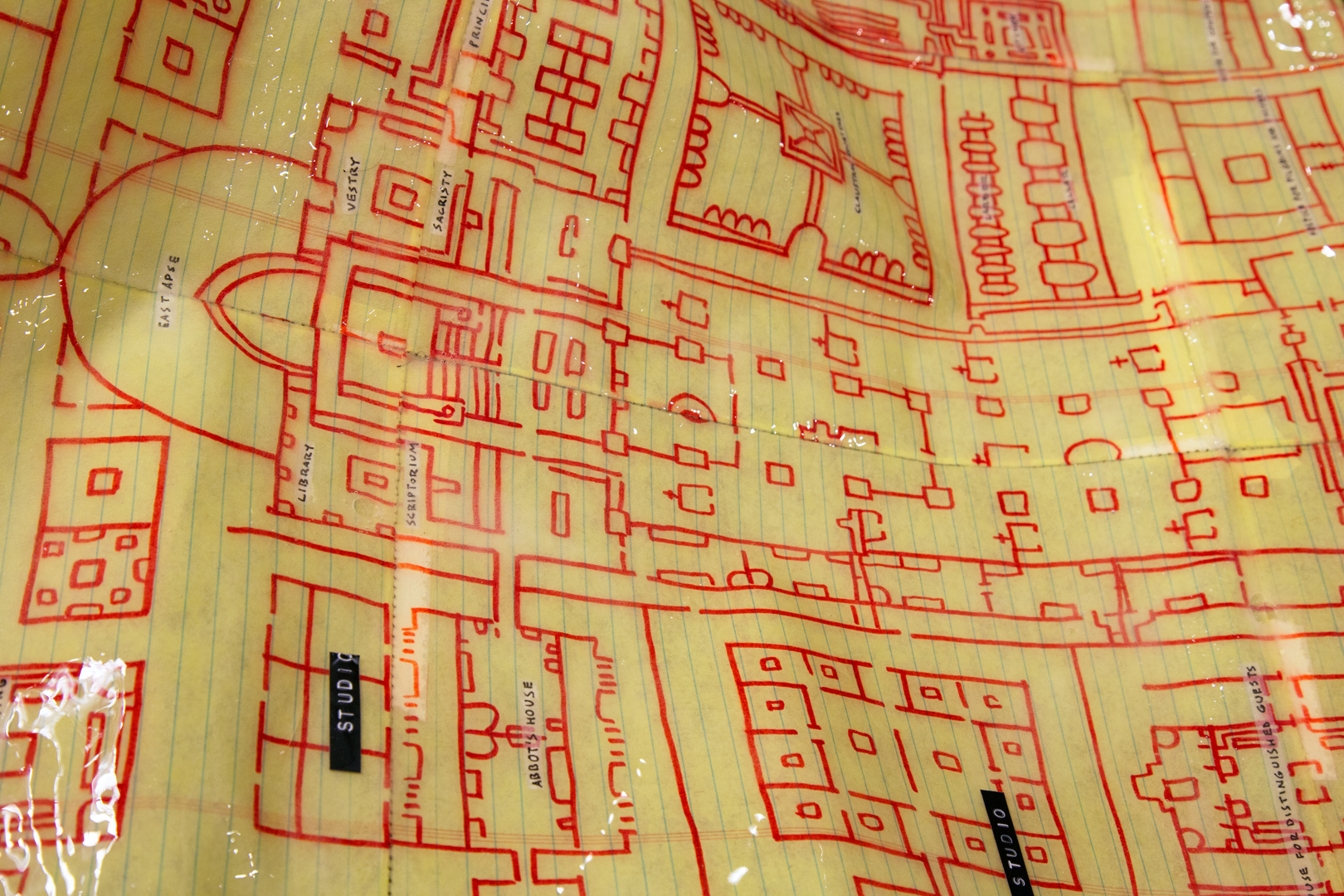
...Simply Look Around and View It
2019
Medium density fiberboard, used masonite, used acrylic, full scale replica of The Plan of St. Gall3 (upon which such thorough research has been conducted, that I can tell you which time of plant is allocated to each row of the vegetable garden: moving from east to west and with the northern row preceeding the southern: fennel, cabbage, parsnip, pepperwort, lettuce, chevril, parsely, shallot, garlic, chard, poppy, radish, dill, corriander, celery, leek, and onion, and the medicianl herb garden which included lily, rose, climbing bean, more pepperwort, costmary, greek hay, rosemary, mint, sage, rue, iris, pennyroyal, water cress, cumin, lovage, more fennel, and dandelion) made from nine sewn wide ruled sunshine sheets and red ink and reinforced with fiberglass, Dymo Organizer 1610 3/8” adhesive labels, every copy of Walden which I could find within walking distance of my studio in one afternoon
2019
Medium density fiberboard, used masonite, used acrylic, full scale replica of The Plan of St. Gall3 (upon which such thorough research has been conducted, that I can tell you which time of plant is allocated to each row of the vegetable garden: moving from east to west and with the northern row preceeding the southern: fennel, cabbage, parsnip, pepperwort, lettuce, chevril, parsely, shallot, garlic, chard, poppy, radish, dill, corriander, celery, leek, and onion, and the medicianl herb garden which included lily, rose, climbing bean, more pepperwort, costmary, greek hay, rosemary, mint, sage, rue, iris, pennyroyal, water cress, cumin, lovage, more fennel, and dandelion) made from nine sewn wide ruled sunshine sheets and red ink and reinforced with fiberglass, Dymo Organizer 1610 3/8” adhesive labels, every copy of Walden which I could find within walking distance of my studio in one afternoon
3. This map, which I reproduced to exact scale of the original 820-830 A.D. artificat (which was itself traced in red ink from a lost original manuscript) before sewing each page together but neglected to think of the seam allowance so the scale and alignment is all sadly slightly off, was hardened with fiberglass and resin over a topographical mold of a pasture hillside in Vermont where I spent a lot of time in the summer growing up. The map represents the monastery in 1:192 scale so I did my best to recreate the hill in the same ration with topographic maps I could find online. The map is also oriented the same way, so that if you are sitting on top of the hill, downhill is west, and the best place to watch the sunset is approximately I think where the novitiate is located.

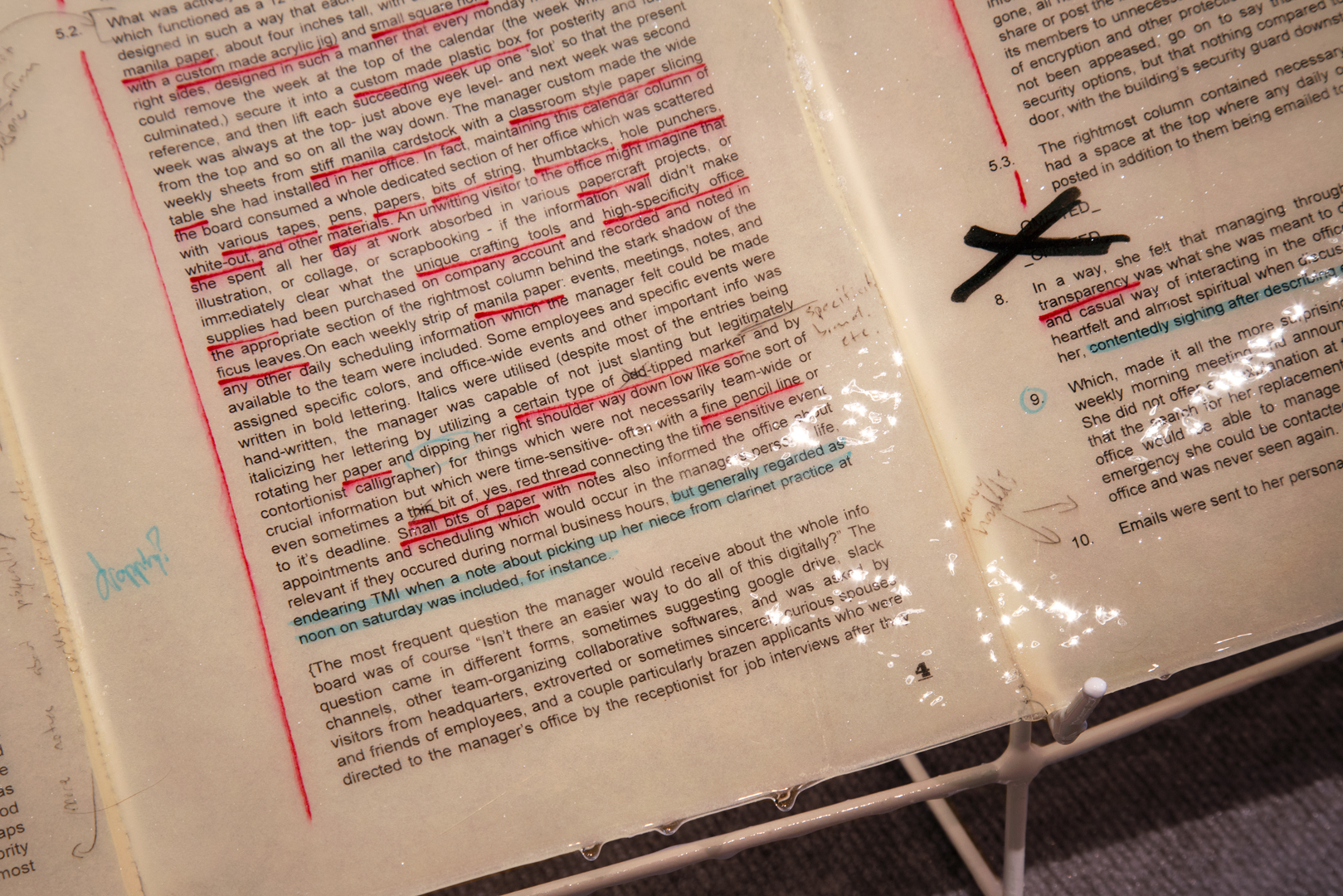
Depth Plunging and The Manager’s Downfall
2019
2019
Fade and abrasion resistant anti-static nylon carpeting, unpainted pine skirting boards, resin soaked epoxy clay, fiberglass reinforced rough draft for a short story about performing workplace management, lamp


The Creature
2019
More pieces of the same desk which was disassembled in making Optimist Club Table with boxes painted in Donald Judd’s Untitled (DSS 42) red4, bits of old sculpture, rug from apartment5, pieces of discarded shipping crates, quarter round moulding, small painted and polished plywood shelves, two Braun slipcast mugs6, backlit print of promotional image from Haim Steinbach’s 7 show Creature at Tanya Bonakdar Gallery in 2011, the upstairs portion of which I count among the best or most revelatory art viewing experiences I’ve ever had and so still think about him and his work often
4. Appropriate tint of red/orange was determined by bringing a New York Times page which featured this Judd wall sculpture and asking the Home Depot paint technician to color match to the middle section of the somewhat faded and severely mis-registered image to which he responded with some hesitation but was not as reluctant as I expected and so all of the pre-meditated or mentally scripted strategic dialogue of convincing him to indulge me which I had prepared while sitting in the parking lot in the snow went unused and has since been forgotten.
2019
More pieces of the same desk which was disassembled in making Optimist Club Table with boxes painted in Donald Judd’s Untitled (DSS 42) red4, bits of old sculpture, rug from apartment5, pieces of discarded shipping crates, quarter round moulding, small painted and polished plywood shelves, two Braun slipcast mugs6, backlit print of promotional image from Haim Steinbach’s 7 show Creature at Tanya Bonakdar Gallery in 2011, the upstairs portion of which I count among the best or most revelatory art viewing experiences I’ve ever had and so still think about him and his work often
4. Appropriate tint of red/orange was determined by bringing a New York Times page which featured this Judd wall sculpture and asking the Home Depot paint technician to color match to the middle section of the somewhat faded and severely mis-registered image to which he responded with some hesitation but was not as reluctant as I expected and so all of the pre-meditated or mentally scripted strategic dialogue of convincing him to indulge me which I had prepared while sitting in the parking lot in the snow went unused and has since been forgotten.
5. This rug on the stepped platform is a slapdash copy of Manfred Pernice sculptures- whos recent New York exhibition I missed, despite having been waiting for a little while for an opportunity to see his work in person. I started making this as a copy of his constructions, as a way of being able to experience his work in person without leaving the studio, but the whole sculpture evolved into something else altogether.
6. Found these wrapped in newspaper in an old box in the back of the basement workshop area as I was gathering up my things and doing some reverse-triage about which belongings of my parents I could amicably co-opt for the design of my burgeoning adult life and upcoming move into my new apartment. I was surprised to find that these, which seemed sort of elegant in their subtle Dieter Rams-ness of slightly smaller size, black eggshell glaze, embossed logo, et cetera, had been tucked away for what must have been at least a quarter century while our whole family had unwittingly been drinking out of boring or regular mugs which had typical mug words like “alumi” or “conference” or “siesta key” printed on them in full color.
7. Around 2013, I was browsing through the endless antique shops of Hudson, New York, when I came across this really amazing candle. It was cast and dyed wax made to look like a thick slice of log. The top of the candle contained every little concentric ring of a cylindrical section of tree trunk with incredible trompe l’oeil detail, and the deep textured bark which surrounded the outside was equally convincing. It was about 10 or 12 inches in diameter, maybe 8 inches tall, and if I hadn’t noticed the subtle wick coming up from the top, and then lifted the object to confirm that it was really fully wax, I would have walked right past it and scoffed at another faux-rustic piece of junk for sale. It's kitchiness and fully convincing illusory design were really fantastic, and after looking at the price tag, I decided I would come back later if I was still thinking about it and hadn’t found anything else cheaper/better. I remember I was shopping for my parents, but can’t remember for what event if any, but thought it would suit the family's woody Maine cabin decor in a way which if it wasn’t appreciated for its craft would at least be accepted for its bizarre humor.
So naturally I kept thinking about that candle and finally decided I could grit my teeth and commit to the wild price, or more horrifyingly: attempt to haggle with the shopkeeper to take the candle home for cheaper- and I returned to the shop later that day but the log candle was gone. I approached the counter to ask about the object, for maybe it had just been moved somewhere else and was still available, and as I began to describe it to the shopkeeper she quickly stopped me, knowing what I was trying to describe and informed me that unfortunately it had been sold. She was chatty and went to tell me that I might not be familiar with this person but that the candle had actually been “bought by an artist named Haim Steinbach, if you’ve heard of him?” which knocked me off my fucking feet but not so much that I couldn’t casually inform her that I did in fact actually know his name and that it was a shame the candle was no longer available.
And I still regularly check up on all of Steinbach’s upcoming exhibitions, and go through all the documentation I can find, keeping an eye out for that big-log-candle on one of his nice plastic laminated plywood display shelves but no luck yet.
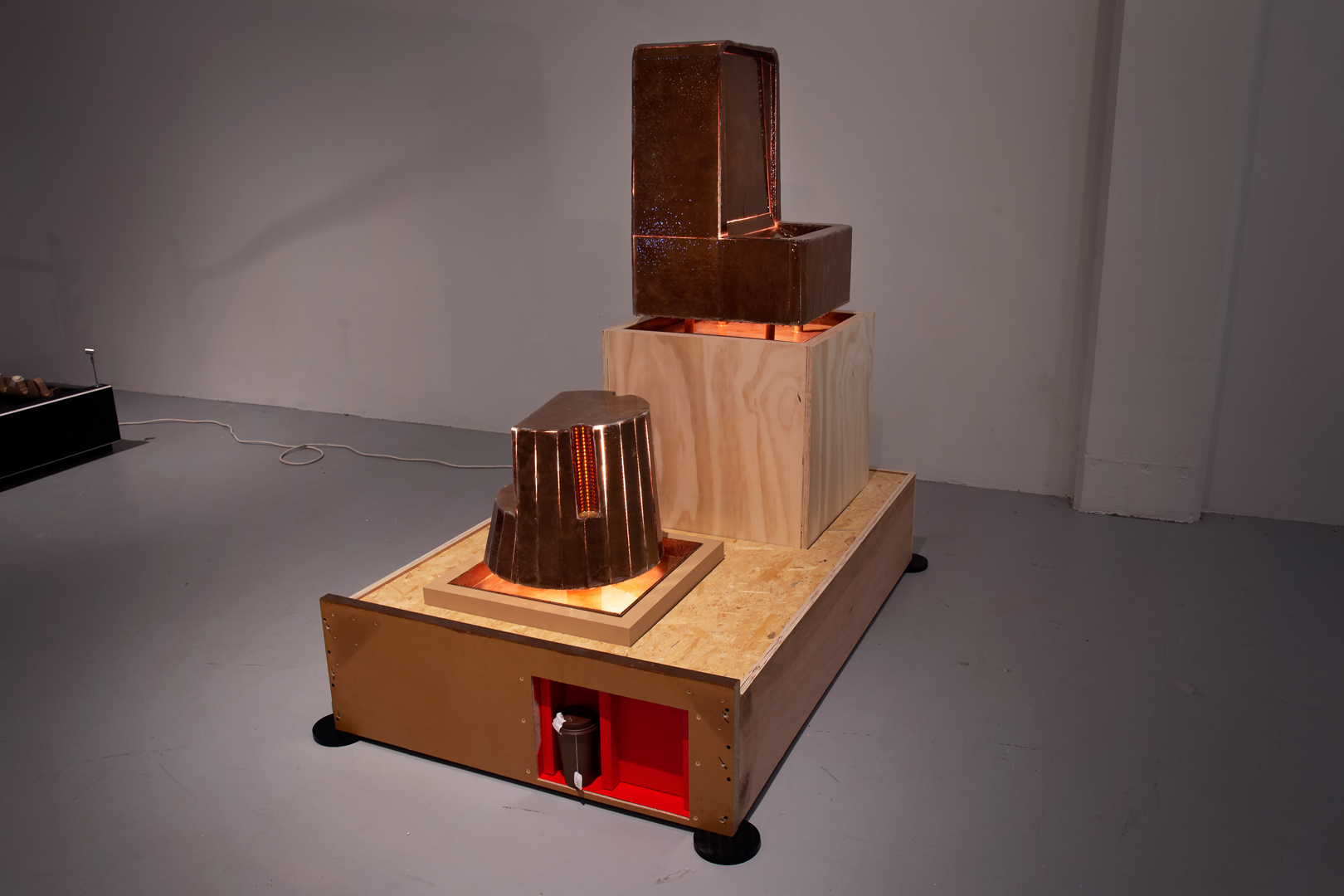
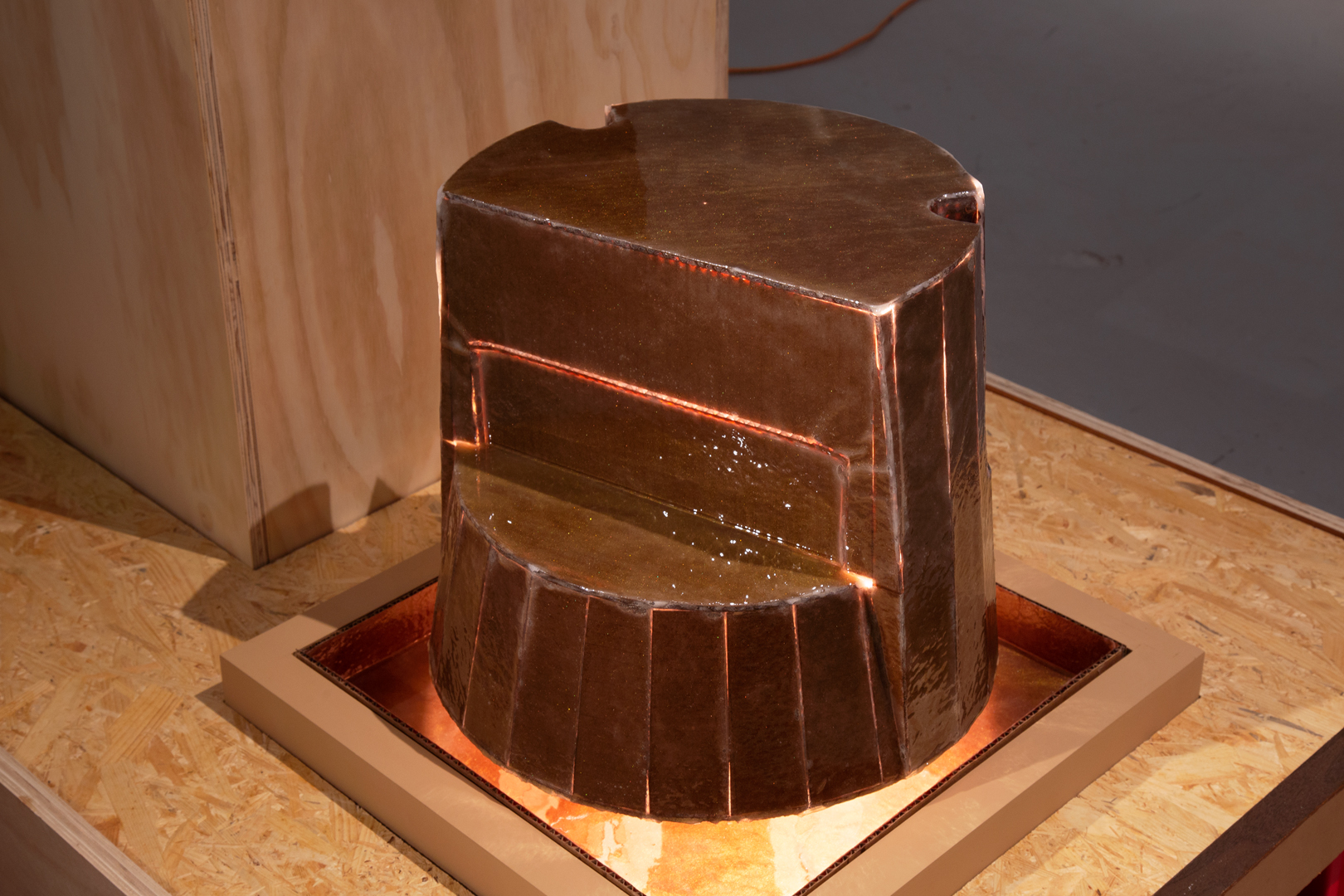
Dandelion
2019
Full scale replicas of drinking fountain and library step stool made from fiberglass reinforced cardboard and pigmented resin, found plywood, found oriented strand board, found particle board, birch plywood, medium density fiberboard painted in the color of itself8, multiple light sources, found red cardboard packaging, found brown cup with brown lid containing dirt from the burial site9 of Leonard Bernstein and medicinal dandelion tea bag from whole foods
*[Just like the dandelion, this show grows out of the middleground. Appearing at the boundaries of care. Protesting monolithic lawn culture. Not too big but not too little. Not too many or too few.] [The dandelion is the opposite of the orchid. Like the inclinations which generated these sculptures, the dandelion is resilient and simple and spontaneous and easy to come by. The orchid requires delicate care and attention and affection over time. One good orchid is enough. Dandelions are a dime a dozen. Or even less.] [Like this show, the dandelion’s life occurs in two phases. Dense yellow then blowball on the wind.]
2019
Full scale replicas of drinking fountain and library step stool made from fiberglass reinforced cardboard and pigmented resin, found plywood, found oriented strand board, found particle board, birch plywood, medium density fiberboard painted in the color of itself8, multiple light sources, found red cardboard packaging, found brown cup with brown lid containing dirt from the burial site9 of Leonard Bernstein and medicinal dandelion tea bag from whole foods
*[Just like the dandelion, this show grows out of the middleground. Appearing at the boundaries of care. Protesting monolithic lawn culture. Not too big but not too little. Not too many or too few.] [The dandelion is the opposite of the orchid. Like the inclinations which generated these sculptures, the dandelion is resilient and simple and spontaneous and easy to come by. The orchid requires delicate care and attention and affection over time. One good orchid is enough. Dandelions are a dime a dozen. Or even less.] [Like this show, the dandelion’s life occurs in two phases. Dense yellow then blowball on the wind.]
8. This was color matched at Home Depot, just like the Judd Creature red boxes. You can buy the material and the color of the material all in one trip.
9. Brooklyn. About fifty steps from the summit of Battle Hill, according to the “Alive at Green-Wood” visitor map.
*The studio is a cup. You, the artist, are a tea bag. And all that has to be done is to fill the cup up with hot water and steep and not spill.
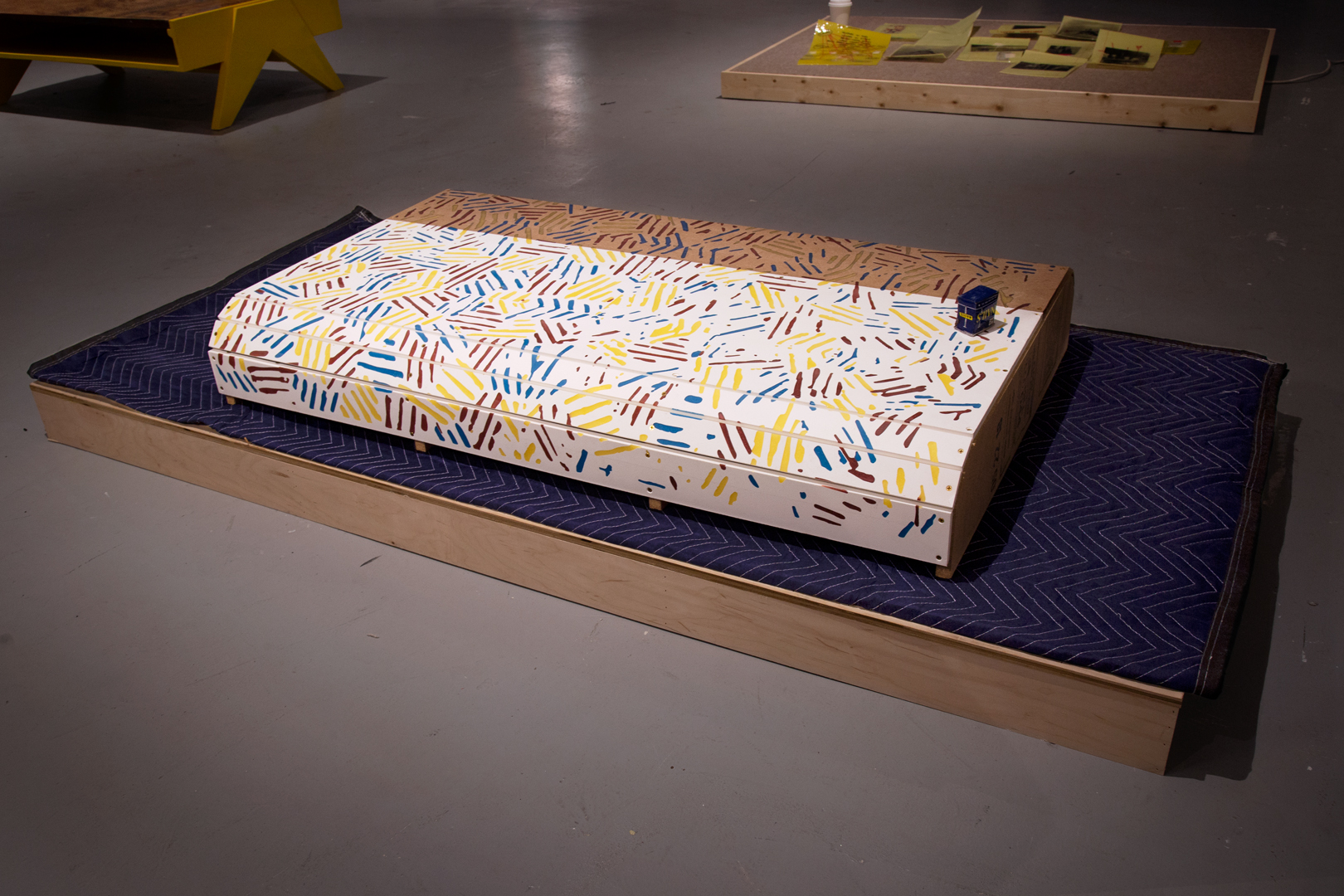
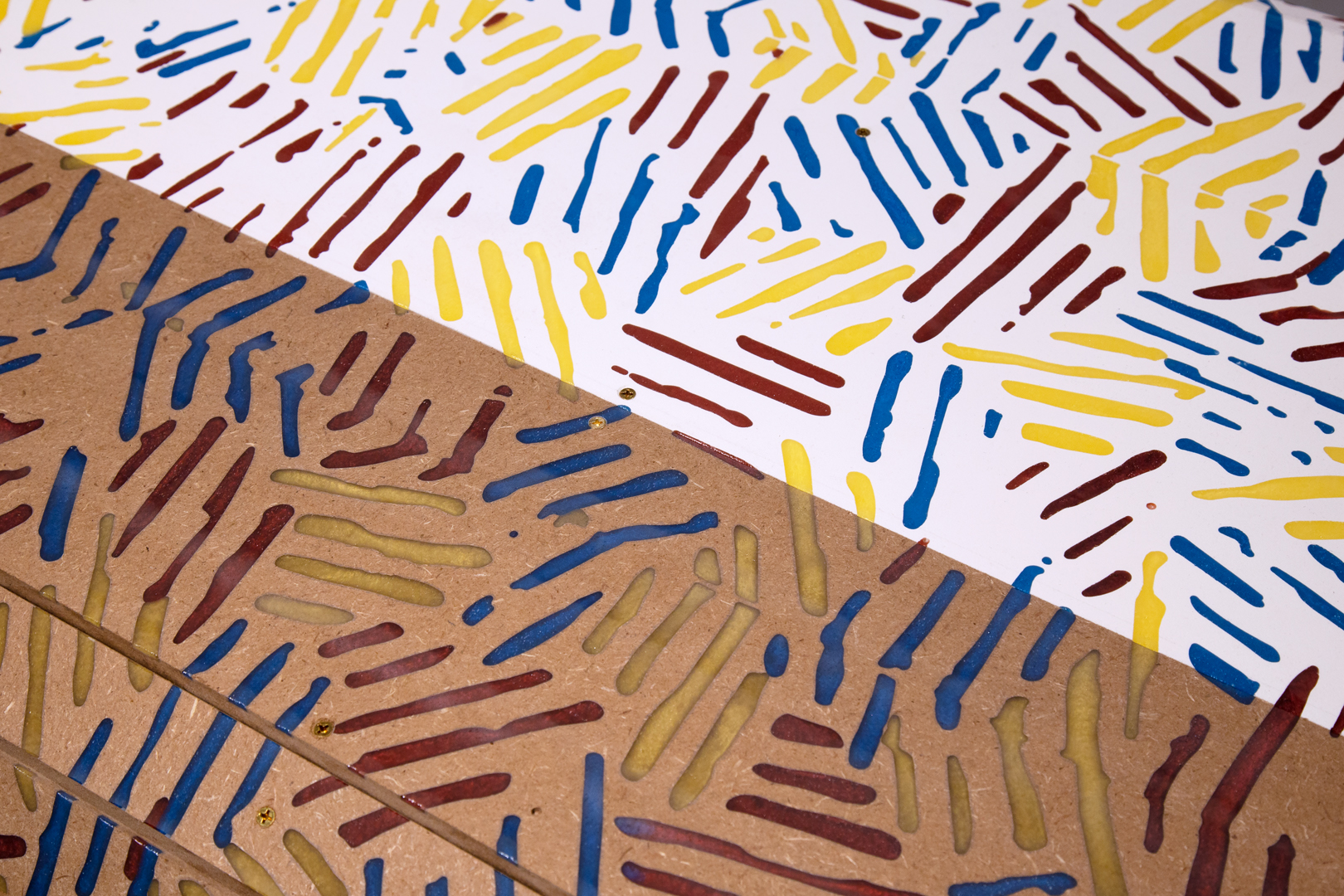
My Corpse and Mirror II
2018
2018
MDF and PVC sheets with design adapted from a 1974 Jasper Johns crosshatch painting CNC routed in, and filled with a resin inlay tinted with sapphire blue, red russet, and citrine Pearl Ex jacquard pigments, found plywood, shipping blanket, small cardboard box, further resin

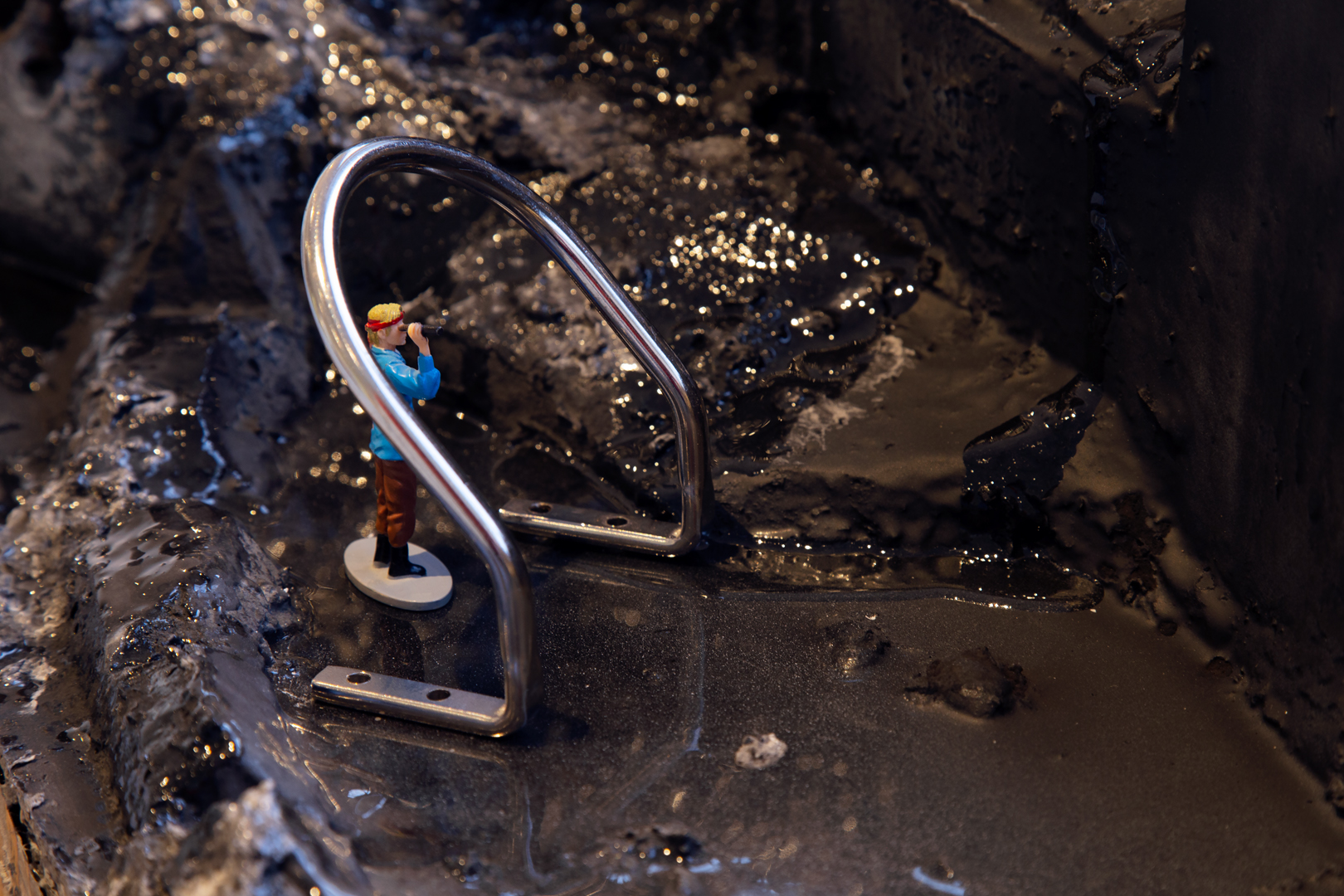

Mordor
2019
Cardboard, urethane, junk, resin, and paper mache model of Sterling Ruby’s 2010 Excavator Dig Site from memory10, spray paint, black snap line chalk, water feature -omitted-, plastic explorer figurine with force field made from aluminum bump guard for hot drink urn spigot, the eye of sauron made from sun maid raisin box and yardstick, clamps, lights, plinth made from mdf scrifical boards, damaged tarp, scrap shipment crate
2019
Cardboard, urethane, junk, resin, and paper mache model of Sterling Ruby’s 2010 Excavator Dig Site from memory10, spray paint, black snap line chalk, water feature -omitted-, plastic explorer figurine with force field made from aluminum bump guard for hot drink urn spigot, the eye of sauron made from sun maid raisin box and yardstick, clamps, lights, plinth made from mdf scrifical boards, damaged tarp, scrap shipment crate
10. I have a bone to pick with Sterling Ruby’s whole vibe but I’m not sure exactly what it is. It seduces and irks me- neither in a productive or discursive way. I was happy to find that the memory of his work could turn evil.
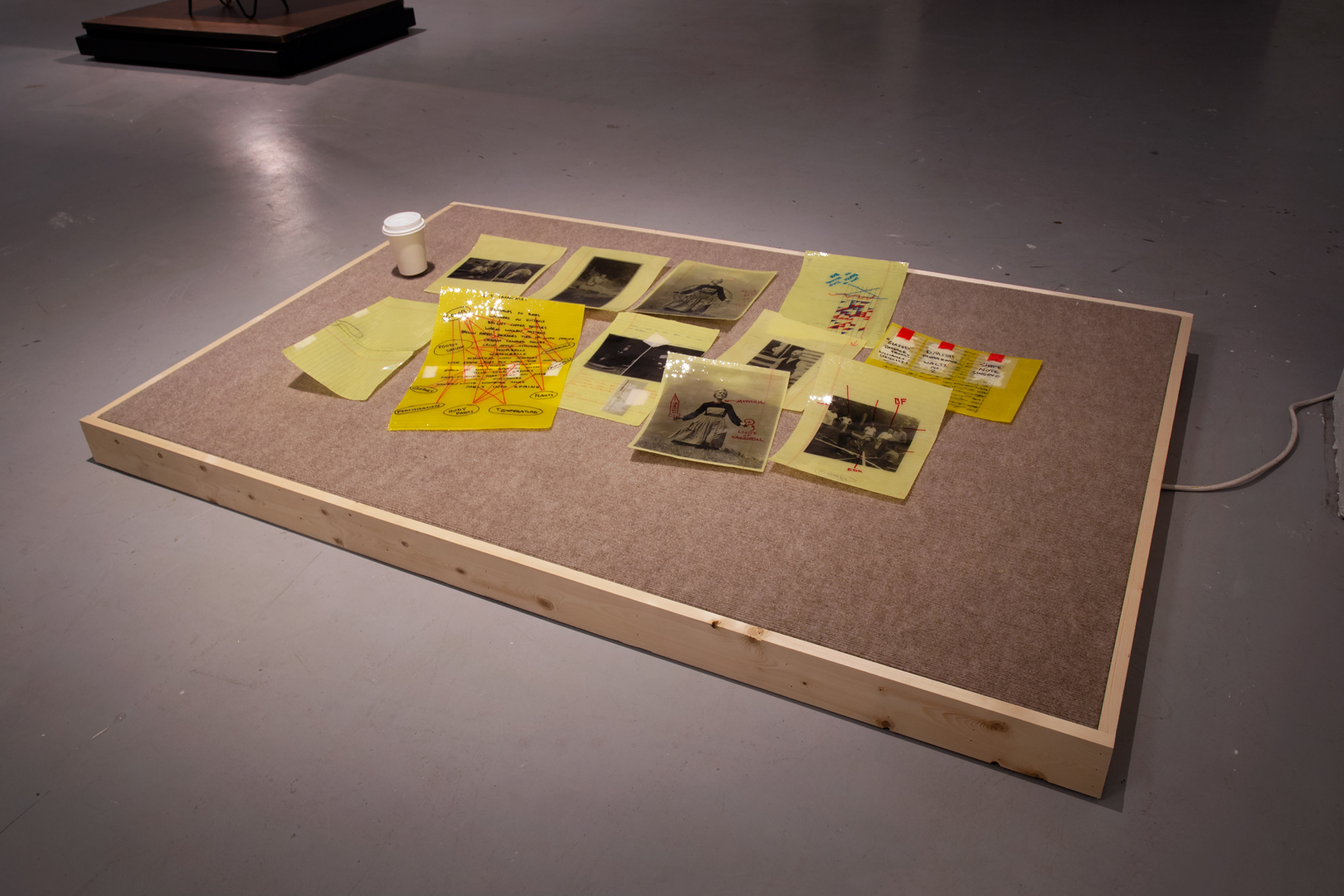

The Directress
2019
2019
Cup containing the ghost of Maria Montessori, fade and abrasion resistant anti-static nylon carpeting, subfloor underlayment oriented strand sheathing, synthetic acoustic absorbent and moisture resistant carpet underlayment, unpainted pine skirting boards, treated pine joists, many fiberglass reinforced studio notes and paper ephemera including: on two taped sheets of Roaring Spring Landscape Sheet an organization of lyrics, on Giant Eagle Canary Legal Sheet a chart created to reinforce self-discipline and self-regulation, on Giant Eagle Canary Legal Sheet clipings of source material from studio and material list drafts, on Mead Cambridge Wide Ruled Sunshine Sheet promotional image from the sound of music with illustrations, on Mead Cambridge Wide Ruled Sunshine Sheet promotional image from the sound of music with 3-frequency dome construction diagram and notes, on Mead Cambridge Wide Ruled Sunshine Sheet image of David Foster Wallace sitting with book and Constantin Brancusi sitting with puppy, on Mead Cambridge Wide Ruled Sunshine Sheet image from page 78 of the Edward Hopper monograph inwhich eyebrows, pupils, and mouth have been altered and taped reminder from studio, on Roaring Spring Landscape Sheet twig identification chart with three taped reminders from studio, on Mead Cambridge Wide Ruled Sunshine Sheet labeled image of the failed erection of a geodesic dome at the Black Mountain College with Elaine de Kooning at center, on Mead Cambridge Wide Ruled Sunshine Sheet note with an image of William Carlos Williams, naked, holding two sticks, by a body of water, et cetera


Double Maria11
2019
11. After (in the order that I became aware of them, as I searched for more examples of this sort of doubling as it relates to identity) Warhol’s Double Elvis, Deborah Kass’ Double Yentl, Chris Ofili’s Double Captain Shit, et cetera.
2019
Plywood, acrylic, fluorescent lighting, incandescent lighting, backlit digital print of decorative grass, backlit digital print of altered promotional image from The Sound of Music, found PBP street barriers -omitted-12, painted medium density particle board, found desktop (all patina of use having occurred while in my posession)
11. After (in the order that I became aware of them, as I searched for more examples of this sort of doubling as it relates to identity) Warhol’s Double Elvis, Deborah Kass’ Double Yentl, Chris Ofili’s Double Captain Shit, et cetera.
12. After Tom Sachs’ use of Con-Ed barriers, but really more like before or beside Tom because I can tell you -from my short stint as a Tom Sachs Studio unpaid intern- that the reflective orange and white barriers appropriated for his constructions are not really lifted from Manhattan sidewalks but fabricated and faux-distressed (as to appear authentic) in-house by a variety of similarly unpaid interns to the studio’s precise specifications, and I don’t mean to reveal this as some sort of retribution for the fact that my only compensation came in the form of “experience” and “if you write a third-person letter of recommendation for yourself- I’ll have Tom sign it” but because I believe this sort of material artifice is perhaps one of the most interesting aspects of his and many other contemporary sculptors’ work, and I did really enjoy my time there, and the “experience” was unquestionably valuable to me, but I did move out of New York 4ish months later when I ran out of money- and the last line of my faux-third-person letter of recommendation which exclaimed “I recommend Max for absolutely any project, position, or ambition because he is without question the most skilled intern our studio has ever had the pleasure of working with.” was promptly edited out either before, after, or during the signing of the letter of recommendation; but I couldn’t tell you which because I wasn’t around for that part.


Double Prone Domes13
2019
Found particle board, non-regulation billiards felt, 357 resin soaked twigs gathered nearby14, lyrics in epoxy clay and tin foil
13. After Supine Dome: a name Elaine de Kooning coined for Buckminster Fuller’s failed attempt to erect a geodesic dome (made from venetian blind slats) with his students at the Black Mountain College in 1948.
2019
Found particle board, non-regulation billiards felt, 357 resin soaked twigs gathered nearby14, lyrics in epoxy clay and tin foil
13. After Supine Dome: a name Elaine de Kooning coined for Buckminster Fuller’s failed attempt to erect a geodesic dome (made from venetian blind slats) with his students at the Black Mountain College in 1948.
14. Two of these are actually bits of paintbrushes, and one is a bunch of toothpicks bundled together, but after ninety minutes of attempting to get a grip on twig identification I can guess that most seem to be white pine, maple, birch, eastern hemlock, white oak, and more white oak.


Stick Displayer
2019
Deck of playing cards inwhich each card has been assigned a sculptor’s name and adhered to a printed example of their work15, painted particle board, found plywood, acrylic, cardboard, polystyrene foam, rubber bands, shoelace, lamp pull chain, imitation formica, jewelry case pinspot lights, stick made from biaxial fiberglass sleeve, resin, extruded polystyrene, and a branch16
15. Made in 2016 in collaboration with a group of middle school boys who only wanted to play poker in art class. We tried our best to create a diverse survey of 52 great artists but most of our time was spent talking about why it’s not appropriate to throw glue sticks and scissors across the classroom. And how, yes, I know they are called safety scissors, but you know that’s not what that means. Stop it.
2019
Deck of playing cards inwhich each card has been assigned a sculptor’s name and adhered to a printed example of their work15, painted particle board, found plywood, acrylic, cardboard, polystyrene foam, rubber bands, shoelace, lamp pull chain, imitation formica, jewelry case pinspot lights, stick made from biaxial fiberglass sleeve, resin, extruded polystyrene, and a branch16
15. Made in 2016 in collaboration with a group of middle school boys who only wanted to play poker in art class. We tried our best to create a diverse survey of 52 great artists but most of our time was spent talking about why it’s not appropriate to throw glue sticks and scissors across the classroom. And how, yes, I know they are called safety scissors, but you know that’s not what that means. Stop it.
16. This unit was originally made to display multiple sticks and some of those that have been omitted include: Bronco brand ranch rake paper mache’d with pink Bruce Nauman body pressure posters, three found broomsticks (one glossy blue, one matte yellow, one painted white before heavy fading and scratching,) replica of Andre Cadere’s Barre de Bois Rond (1973,) further fiberglass swords of knotweed with various grips like the one displayed on Optimist Club Table, branch wrapped in gauze and plaster and then fiberglass and FGR plaster, and with a final coat of resin (one of the first sticks I made 6 or so years ago, and which I have been carrying around with me- really proud of it), found nice one and a half inch diameter hardwood dowel.


The Bomber
2019
Live-edge OSB, found plywood, medium density fiberboard, dowels, and hemlock stained with dunkin’ donuts’ original blend coffee, reliquary for Edward Hopper Monograph vandalized by Vermont High School Students17, a bunch of used chip brushes all resined together18, two studio stools made in 2011 and used ever since, some nice little yellow rubberized hooks
17. Stamped on the inside cover and tail edges of the pages is “Champlain Valley Union High School Library” and the scrawled inscription on the first page reads: “This Book was defaced by CVU high school students- they were not so kind. Please excuse the drawing and unkind graffiti on some of the pictures.” and also “Given to Kate Hodge by Pat Mraz CVU librarian - 1998”
2019
